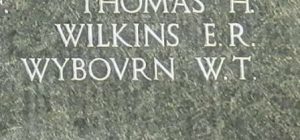Hirwaun, or Hirwain, is a village and community at the north end of the Cynon Valley in the ancient county of Breconshire, which sits on the Heads of the Valleys Road and is located at the southern edge of the Brecon Beacons National Park. The village now lies within the modern county of Rhondda Cynon Taf. The village was centred around the Hirwaun Ironworks and the famed South Wales coalfields and after the ironworks closed, coal mining continued to be a major employer until the second half of the 20th century. The steelworks were owned by the Crawshay family, which also owned large parts of the village. The men of the village who fell during the Great War, and the men and one woman who died during the Second, are commemorated on the Hirwaun War Memorial, which takes the form of a clock tower, situated in the centre of the village. There are several names missing from the memorial, including one woman killed in London in WW2, whose details I have taken the liberty of adding. Also on the memorial is one of the few Welshmen who was Shot at Dawn during the Great War.
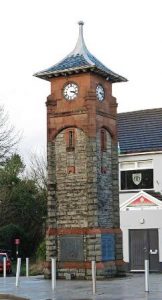
The Great War, 1914-1918
John Ashley, Private, 80973, The King’s (Liverpool Regiment). John was born in Wellington, Shropshire in 1872, the son of Edward Ashley and Lucy Ashley (nee Newbrook). He moved to Hirwaun to work at some time after 1911 and set up home with Edith Phillips (nee Howells), a widow, at 13, Manchester Place, Hirwaun. Edith had two children from her husband, David John Phillips, who had died in the summer of 1911, and she became the unmarried wife of John Ashley. The couple then had their own child, Frances Edith Ashley, born in 1915. John enlisted into the King’s Shropshire Light Infantry at Aberdare but was then transferred to the Royal Welsh Fusiliers. Probably because of his age, he was subsequently transferred to the 2nd (Garrison) Battalion, King’s (Liverpool Regiment) which was based at Pembroke Dock, as part of the large garrison guarding the Royal Naval Dockyards. In January 1917 the battalion embarked for France, then entrained for Marseilles, before sailing for Salonika, where it was to go on Lines of Communication Work. John had only been in Salonika a month when he was killed in action on 27 February 1917. The 42-year-old was buried in Salonika (Lembet Road) Military Cemetery, Greece.
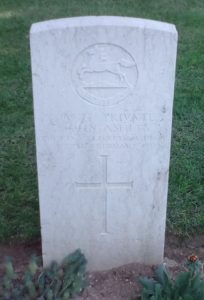
Thomas George Austin, Private, 11001, South Wales Borderers. Thomas was born in 1893, the son of Herbert Frederick Austin and Mary Elizabeth Austin (nee Griffiths), of 13, Green Street, Aberdare. Thomas worked as a coalminer prior to enlisting into the 1st Battalion, South Wales Borderers in 1911. He embarked for France with the 1st Battalion, South Wales Borderers and disembarked at Le Havre on 13 August 1914. The battalion was attached to 3 Brigade, 1st Division and entrained for the Belgian frontier, near the town of Mons. The Division then took part in the Battle of Mons on 23 August, following the German invasion of the low countries, and in the epic withdrawal from Mons to the River Marne, where the German drive on Paris was halted. The Germans then withdrew north and took up defensive positions north of the river Aisne, along the Chemin des Dames Ridge and the BEF advanced before launching a frontal attack upon the German positions. Following this Battle of the Aisne, the opposing sides dug-in and the BEF then began moving to Flanders on 17 October, before advancing from Poperinghe past endless numbers of refugees and took up positions guarding the strategically vital city of Ypres, the 1st Division taking up positions near Langemarck by 21 October. Later that day the division was attacked by hordes of Germans, mainly young student-soldiers, who were mown down by the highly trained British soldiers. The Germans maintained their attacks over the coming days but were held at bay, sustaining terrible losses, and the line here stabilised, so by 27 October the 1st Division moved to positions near Zandvoorde, guarding the Menin Road. On 31 October 1914 the 1st Division faced its sternest test so far, when the Germans attacked its positions on the Menin Road, behind a fearsome artillery bombardment. Thomas was wounded during this period of the war and was evacuated by hospital train to the American Ambulance in Neuilly-sur-Seine, Paris, where he died of his wounds on 31 December 1914. The 21-year-old is buried in Neuilly-Sur-Seine New Communal Cemetery, France.
Thomas George Barnes, Private, 40587, Worcestershire Regiment. Thomas was born in 1897, the son of Thomas Charles Barnes and Alice Barnes (nee Tandy), of 14, Hawthorn Terrace, Aberdare. The family had moved to 16, Cynon Place, Hirwaun by 1909. Thomas enlisted at Aberdare into the 5th Battalion, Welsh Regiment soon after the outbreak of war. Whilst training he was transferred to the 2/7th Battalion, Royal Warwickshire Regiment, but upon being drafted to France in the summer of 1916, Thomas was posted to the 4th Battalion, Worcestershire Regiment. The battalion was attached to 88 Brigade, 29th Division and had moved to France from Egypt in March 1916, following the closure of the Gallipoli campaign and had taken up positions near Beaumont Hamel, facing Y-Ravine. The Division had an arduous time here over the coming months, before taking part in a suicidal assault on 1 July 1916, on the opening day of the Somme offensive, which saw the assaulting battalions virtually annihilated. Although severely depleted, the Division remained in the line here over the coming weeks, in trying conditions. The Division was then pulled out of the line to rest and rebuild before moving back into the line and taking part in the latter stages of the Somme offensive. The Division wintered on the Somme, taking part in the advance which followed the German withdrawal to the Hindenburg Line. At the beginning of April, the entire 29th Division moved out of the Somme sector to the Arras sector, and by 9 April took over a section of the line facing Monchy-le-Preux. The Division then began to prepare for the forthcoming Battle of Arras. At dawn on 23 April 1917, the Division launched an assault on Monchy-le-Preux. Thomas was severely wounded in the arm and leg during the fighting for Monchy and was evacuated to the Canadian Hospital, at Étaples. He died there of his wounds on 4 May 1917. The 19-year-old is buried in Étaples Military Cemetery, France.
William Alfred Bowen, Private, 271, Welsh Guards. William was born in 1883, the son of Alfred Bowen and Elizabeth Bowen (nee Jenkins), of 10, Merthyr Road, Hirwaun. He married Keziah Margaret Price, of Penderyn, in 1906 and the couple set up home at 4, Pontbren, Penderyn. Keziah died in 1908, two years after the birth of their only child, daughter Elizabeth Hannah Bowen, in 1908, and William moved with his young daughter back in with his parents. William worked as a coal hewer prior to the war and enlisted into the Grenadier Guards soon after the outbreak of war. In February 1915 he became one of the first men to transfer from the Grenadier Guards to the newly formed 1st Battalion, Welsh Guards. The Regiment had been raised by Royal Warrant of 26 February 1915, at White City, before landing at Le Havre on 18 August 1915, becoming attached to 3rd Guards Brigade, Guards Division. The Division saw its first major action during the Battle of Loos, which began on 25 September 1915. During the opening day, the Guards Division began moving into position, watching the terrible scenes in front of them, before launching its own attack on the following morning. At around 18.00 that day the Welsh Guards received orders to attack a feature called Hill 70, and as the men slowly made their way forwards, darkness fell. As soon as the battalion reached the top of the Hill, German machine-gunners opened up a murderous fire on them, forcing the men to dig into the many shell holes littering the crest, before retiring to positions just below of the crest, where the survivors dug-in. William was badly wounded during the horrific assault on Hill 70 and died of his wounds on 27 September 1915. The 32-year-old has no known grave and is commemorated on the Loos Memorial, France.
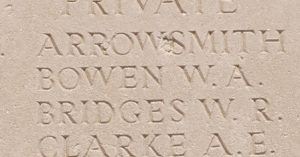
Charles Cartlidge, Private, 12772, South Wales Borderers. Charles was born at Hirwaun in 1897, the son of John Cartlidge and Emily Cartlidge (nee Jackson). The family had moved to Merthyr by 1901, then Aberkenfig by 1911, before settling at 173, Bridgend Road, Newcastle Higher. Charles enlisted at Pontycymmer into the 4th Battalion, South Wales Borderers soon after the outbreak of war. The battalion formed at Brecon, before moving to Park House Camp, near Tidworth to join 40 Brigade, 13th (Western) Division, then moved to billets in Cirencester before moving to Woking in March 1915 for final training. On 29 June 1915 the Division sailed from Avonmouth for Mudros, before landing at Cape Helles, Gallipoli on 15 July 1915. Two weeks later the Division was moved to Anzac, to reinforce the Australian and New Zealand troops there, in readiness for a great assault on the Sari Bair Ridge, in conjunction with fresh Allied landings at Suvla Bay. The assault began on 6 August 1915 and raged over the coming days. The 4th SWB reached the Achyl Dere before assaulting, and seizing Damakjelik Bair, one of the ridges held by the Turks. The Turks counter-attacked on 9 August and terrible fighting raged throughout the day. Charles was killed in action during the initial assault on 6 August 1915. The 18-year-old has no known grave and is commemorated on the Helles Memorial, Gallipoli. Charles is not commemorated on the Hirwaun war memorial. His brother, James Ernest Cartlidge died at Pembroke Dock whilst serving with the 6th Welsh in 1916.
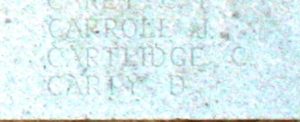
John Henry Coomer, Private, 20249, Somerset Light Infantry. John was born in Axbridge, Somerset in 1899, the son of James Coomer, a retired soldier, and Hannah Coomer (nee People). His mother died just after his birth, so John was sent to the Union Workhouse at Axbridge. By 1911 he was living with the Lintern family, at the Brickyard, Burrington, then just prior to the war he moved to Hirwaun to lodge with his newly married sister, Elizabeth Mary Davies, and her husband Charles, at 14, Bethel Place. John worked as a coalminer at Hirwaun prior to the war. He enlisted into the Somerset Light Infantry at Aberdare early in 1915. John was drafted to France early in 1916, joining the 6th Battalion, Somerset Light Infantry, which was attached to 43 Brigade, 14th (Light) Division. John probably joined the battalion whilst the division was still in the Ypres Salient. In June 1916 the division moved to the Agny area to train prior to being moved into the Blangy sector at Arras. The division was relieved at the end of July and moved south to the Somme, to take part in the bloody fighting for Delville Wood, and reached Albert by 7 August. A scouting party from the battalion then advanced into Delville Wood, to reconnoitre the area before the 6th Somerset’s moved into the line in the devastated wood on 12 August. The wood had by now been almost totally cleared, but the Somerset’s still spent three arduous days fighting to the northeast of the wood. The battalion was relieved on 15 August and enjoyed a brief rest at Montauban before moving back into the line northeast of the wood to take part in an assault upon a trench system called Hop Alley. John was killed in action during this assault, which was launched at dawn on 19 August 1916. The 16-year-old has no known grave and is commemorated on the Thiepval Memorial, France.
Robert Corfield, Gunner, 1011, Royal Field Artillery. Robert was born in 1887, the son of George Corfield and Elizabeth Corfield (nee White), of 43, North Parade, Aberystwyth. He was a pre-war Territorial with the Cardigan Battery, Royal Garrison Artillery. Robert had lived at Hirwaun for many years prior to the war, where he ran his own Hairdresser’s at Cross Street. He was mobilised at the outbreak of war and moved with the Cardigan Battery to Bedford. On 26 August 1915, the Battery was on manoeuvres when Robert fainted whilst sat on a gun carriage, and fell backwards, under the wheels. He received a broken jaw and depression to the back of the head, which killed him instantly. Robert was 27 years old and was buried with full military honours in Aberystwyth Municipal Cemetery. Robert was not commemorated by the CWGC until I submitted his case to them on 5 August 2012. On Friday 7 February 2014, Robert was accepted for commemoration by the CWGC. Robert is not commemorated on the Hirwaun war memorial.
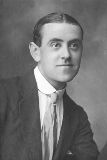
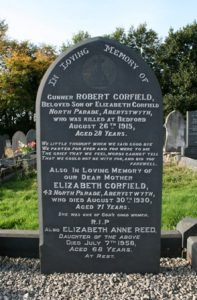
Richard Davies, Private, 8557, Dorsetshire Regiment. Richard was born at Abercanaid on 2 August 1878, the son of John Aubrey Davies and Rachel Davies (nee Thomas). His mother’s parents ran the Brecon Arms at Penderyn, and Richard lived with his grandfather there for several years as a young boy, before going to live in America with his parents for several years, as his father ran a colliery in Pennsylvania. Upon the family’s return to Wales, Richard finished his education at Penderyn, before leaving home to enlist into the Somerset Light Infantry on 24 April 1899 and served in South Africa during the Anglo-Boer War of 1899-1902. After the war he returned to Wales again and began work at the Tower Colliery. He married Catherine Thomas at Glynneath on 31 May 1906, and the couple moved to 30, Station Road, Hirwaun, where they had two children over the coming years. As an army reservist, Richard was mobilised at the outbreak of war, re-joining his old regiment, the Somerset Light Infantry. He was transferred to the Dorsetshire Regiment the following month, before embarking for France on 28 December 1914, joining the 1st Battalion, Dorsetshire Regiment. The battalion was attached to 15 Brigade, 5th Division and was resting at billets at Bailleul when Richard arrived. On 4 January 1915, the battalion moved back into the line near Wulverghem to begin a routine tour in the trenches, Richard’s first taste of life on the Western Front. Over the coming weeks, his battalion rotated in the line and during its rest periods marched to billets at Dranoutre. On 3 March 15 Brigade joined the 28th Division, which had been formed from regular army units which had returned from service throughout the Empire and moved to new positions in the Ypres Salient. Richard was wounded in the left shoulder and side by shell fragments on 8 April and was treated at the 14th Field Ambulance before being evacuated by No 7 Ambulance Train to the 4th General Hospital at Versailles. He died there of his wounds on 17 April 1915. The 36-year-old was buried in Les Gonards Cemetery, Versailles, France.
William John Davies, Private, DM2/138313, Army Service Corps. William was born at West Lodge, Merthyr, a small hamlet near Meidrim, in Carmarthenshire in 1892, the son of John and Ann Davies. He was adopted by Thomas Prosser and Naomi Prosser (nee Stephens), of High Street, Hirwain, and served an apprenticeship with Thomas as a painter and decorator upon leaving school. William enlisted into the Army Service Corps at Aberdare on 3 January 1916 and was posted to the MT Depot at Osterley Park to learn to drive. On 27 April 1916 he was drafted to France and joined the 7th Ammunition Sub Park, but was then attached to the 125th Heavy Battery, Royal Garrison Artillery. William would have been tasked with driving motorised lorries which were used to pull guns and ammunition into place on the Somme for the battery in the weeks leading up to the Somme offensive which was launched on 1 July 1916. William was killed in action near Mametz Wood on 9 July 1916. The 20-year-old is buried in Dantzig Alley British Cemetery, Mametz, France. William is not commemorated on the Hirwaun war memorial.
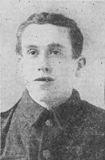
John Drew, Private, 54082, Welsh Regiment. John was born in 1892, the son of William Drew and Mary Drew (nee Jones), of 1, Cynon Terrace, Hirwaun. He worked as a coal hewer prior to the war and was a talented footballer, who played for the Hirwaun Stars A.F.C. John enlisted at Aberdare into the 5th Battalion, Welsh Regiment during the spring of 1915, but was then transferred to the 17th Battalion, Welsh Regiment. The battalion was raised in January 1915 as a Bantam Battalion, made up of men of below average height, and initially went to Porthcawl attached to the 43rd (Welsh) Division. During July 1915 the battalion moved to Prees Heath to join 119 Brigade, 40th (Bantam) Division and landed in France with the Division in June 1916. The Division moved to positions around Lillers before taking over the North Maroc Sector, near Loos, for trench initiation and once acclimatised was left to hold the sector itself over the coming months. The infantry battalions of the Division then began the usual routines of rotating for duty in the trenches: normally four days in the front line; four in support and four in reserve. Late in 1916 the Division moved south to the Somme, and fought at the Battle of the Ancre, before remaining in the sector over the winter. In March 1917 the Germans withdrew to their shortened line, called the Hindenburg Line, and the 40th Division was among the units which followed the withdrawal. Later in the year the Division took part in the Battle of Cambrai and launched an attack on Bourlon Wood on 23 November 1917. The attack was carried out by 119 Brigade, led by the 12th SWB and 19th RWF. The 17th Welsh was in support for the initial assault, but was soon ordered to advance, to support the two attacking battalions. Heavy fighting raged within the wood over the coming days, with the 18th Welsh also being thrown forwards into the fight, and the Division suffered terribly. John was killed in action in Bourlon Wood on 25 November 1917. The 25-year-old has no known grave and is commemorated on the Cambrai Memorial, Louverval, France.
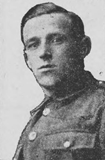
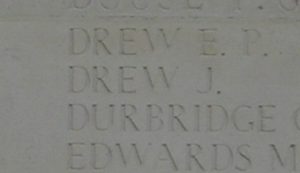
Gwilym Edmunds, Private, 457526, Labour Corps. Gwilym was born in 1883, the son of William Edmunds and Anne Edmunds (nee Williams), of 69, Brecon Road, Hirwaun. He married Maud Morgan at Hirwaun on 9 July 1913 and the couple set up home at Manchester House, Hirwaun, where Gwilym worked as a tailor and outfitter. He enlisted into the army on 9 December 1915 and was posted to the Labour Corps. Gwilym served continuously throughout the rest of the war, until being discharged due to ill health on 9 August 1918, returning home to his wife at Hirwaun. He died of tuberculosis at home on 12 April 1923, aged 40. Gwilym is not commemorated as a casualty by the CWGC, nor is he commemorated on the Hirwaun war memorial.
David Morton Wayne Evans, Lieutenant, Monmouthshire Regiment. David was born in 1897, the son of John William Evans and Elizabeth Ann Evans (nee Richards), of Belle Vue, Hirwaun. He enlisted into the 24th (2nd Sportsman’s) Battalion, Royal Fusiliers soon after the outbreak of war. The battalion was raised in London by Emma Cunliffe-Owen on 20 November 1914, then in June 1915 moved to Clipstone Camp, Notts, to join 99 Brigade, 33rd Division. David embarked for France with his battalion on 15 November 1915, and the entire 33rd Division assembled near Annequin in the Loos Sector. The 24th Royal Fusiliers then transferred to the 2nd Division, which was at Fontes. In the summer of 1916, the Division were on the Somme, taking part in the Battle of Delville Wood; the Battle of the Ancre, and the ensuing Operations on the Ancre. In March 1917, the Division followed the German Retreat to the Hindenburg Line, and in April took part in the Battle of Arras. David left the battalion after being granted a commission as Second Lieutenant into the Monmouthshire Regiment on 25 April 1917. He served for the duration of the war but had either been wounded or contracted an illness towards the time of the Armistice, as he died at the 1st General Hospital, Cambridge on 10 April 1919. The remains of the 22-year-old were conveyed back home, and he was buried in St. Cynog’s Churchyard, Penderyn.
John Evans, Driver, W/206, Royal Field Artillery. John was born in 1882, the son of Evan Evans and Hannah Evans (nee Thomas), of 19, Dowlais Street, Cwmdare. He moved in with Hannah Priddy in about 1906 and the couple lived as husband and wife at 12, Gamblyn Terrace, Hirwaun, where their daughter, Evelyn, was born in 1915. John enlisted at Aberdare into the Welsh Divisional Royal Field Artillery and was posted to North Wales for training. He then joined C Battery, 119th Brigade, Royal Field Artillery, of the 38th (Welsh) Division. The Division began moving to France on 2 December 1915 and moved to the Nursery Sector near Fleurbaix for trench initiation alongside the Guards Division. The Division then held a sector of the line near Cuinchy before marching south to the Somme sector in June 1916 to take part in the assault on Mametz Wood. The first attack on the wood was launched on a two-battalion front on 7 July, but failed, and the Divisional Commander, Sir Ivor Philipps, was replaced before the Division attacked again on a two Brigade front on 10 July 1916. After two days of ferocious hand-to-hand fighting, the wood was cleared up to its northern edge, before the battered Division was relieved. It then took over a section of the front at Hébuterne before moving to the Ypres Salient and taking over the Canal Bank sector at Boesinghe. The infantry battalions of the Division then began carrying out the normal pattern of rotation in the trenches, four days in the front, four in support and four in reserve, whilst also working on trench improvement, digging new trenches, and also carrying out regular patrols and trench raids. John was wounded at Elverdinghe in May 1917, just before the battery was relieved. He was evacuated to the hospital at Remy Sidings where he died of his wounds on 30 May 1917. The 35-year-old was buried in Lijssenthoek Military Cemetery, Belgium.
Arthur Gaylard, Private, 2288, Welsh Regiment. Arthur was born at Martock, Somerset on 23 December 1880, the son of James Gaylard and Elizabeth Gaylard (nee Shumake). The family moved to 19, Compass Street, Swansea by 1891. Arthur married Gwennie Richards at Swansea in 1903 and the couple moved to 4, Watkin Court, Hirwaun, where Arthur had found work as a coalminer. Arthur enlisted into the Welsh Regiment at Pontygwaith and was and was drafted to France on 2 April 1915, joining the 1st Battalion, Welsh Regiment, which was at Dranoutre, attached to 84 Brigade, 28th Division. The Battalion had been seconded to the 5th Division, but within days of Richard’s arrival, moved to Ypres to re-join the 28th Division. The Division was holding a section of front line running from Wytschaete to the Ypres to Zandvoorde road. On 17 April the 1st Welsh marched up to relieve the 5th Fusiliers at Broodeseinde, just beyond Zonnebeke, on the extreme point of the Ypres Salient. On 22 April the Germans launched a poison gas attack at Gravenstafel, the first such attack of the war, and broke the line which was being held by a French Colonial Division. The Canadians rushed in to plug the gap, but this heralded the opening phase of the Second Battle of Ypres and soon afterwards the 1st Welsh became dragged into the terrible fighting. Arthur was badly wounded on 17 April and was evacuated to the 2nd Stationary Hospital at Boulogne, where he died of his wounds on 23 April 1915. The 33-year-old is buried in Boulogne Eastern Cemetery, France.
Foster Lawrence Golding, Sergeant, R/855, King’s Royal Rifle Corps. Foster was born at Charlton, Wiltshire in 1897, the son of William Golding and Sarah Maria Golding (nee Powney). He left home as a young man to find work as a colliery helper and lodged with his sister Mary and her husband at 21, Harris Street, Hirwaun. Foster enlisted into the King’s Royal Rifle Corps at Tonypandy on 1 September 1914 and was posted to the regimental depot at Winchester. Foster was then posted to the 10th Battalion, King’s Royal Rifle Corps, which was at Blackdown attached to 59 Brigade, 20th (Light) Division. Foster landed at Boulogne with the battalion on 21 July 1915, and the entire division moved to the Fleurbaix Sector for trench familiarisation and training. When the Battle of Loos was launched on 25 September 1915 the Division fought a diversionary attack towards Fromelles. Later that year it moved north, and fought at the Battle of Mount Sorrel alongside the Canadian Corps. The division then moved south and fought through the Somme Offensive, at the Battles of Delville Wood, Guillemont, Flers-Courcelette, Morval and Le Transloy, and took part in the advance to the Hindenburg Line in March 1917. Later that year the division moved to Flanders and fought at the Third Battle of Ypres, seeing heavy fighting the Battle of Langemarck, the Menin Road, and Polygon Wood, before moving south in November, to take part in the Battle of Cambrai. The division remained in the area between Cambrai and St. Quentin over the winter of 1917/18, then in February 1918 the 10th KRRC was disbanded, and Foster was posted to the 11th KRRC, in the same division. The division was holding the line on 21 March 1918 when the Germans launched their great offensive along the section of the Western Front running south from Croisilles to La Fère. Foster’s new battalion was out of the line when the German offensive hit and moved forwards to help the beleaguered units desperately holding out in the front line. Foster was killed in action here on 22 March 1918. The 21-year-old has no known grave and is commemorated on the Pozieres Memorial, France. Foster is not commemorated on the Hirwaun war memorial, although his brother, William, who was killed in 1914, is.
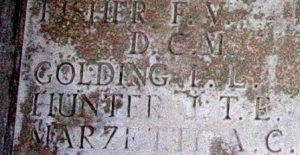
William Golding, Private, 5616, Wiltshire Regiment. William was born at Calne, Wiltshire in 1882, the son of William Golding and Sarah Maria Golding (nee Powney). He left Wiltshire after gaining work at Hirwaun brickworks and was lodging with William White at 4, Penyard Road, Hirwaun by 1911. William then gained work for the Great Western Railway at their engineering department at Hirwaun. He married Sarah Frayling at St. John’s, Aberdare on 7 February 1914 and their only child, William, was born in November that year. William was an army reservist, and re-enlisted into the Wiltshire Regiment at Kilworth, Wiltshire soon after the outbreak of war. He was drafted to France on 21 September, joining the 1st Battalion, Wiltshire Regiment, which was on the Marne attached to 7 Brigade, 3rd Division. The Division had taken part in the Battle of Mons on 23 August, following the German invasion of the low countries, and in the epic withdrawal from Mons to the River Marne, where the German drive on Paris was halted. The Germans then withdrew north and took up defensive positions north of the river Aisne, along the Chemin des Dames Ridge and the BEF advanced before launching a frontal attack upon the German positions, in an action known as the Battle of the Aisne, which saw both sides entrench, and the Western Front thus began to form. The BEF then began moving to Flanders in October, the 3rd Division taking over positions near Neuve Chapelle by 16 October 1914, before digging in around the Bois de Biez. On the following morning, 7 Brigade advanced and dug in east of Ligny le Grand, and on 18 October launched a counterattack against the Germans, gaining some 200 yards of ground. Heavy fighting raged here over the coming days as both sides battled for supremacy. William was killed in action during a day of desperate fighting, on 25 October 1914. The 32-year-old has no known grave and is commemorated on the Le Touret Memorial, Richebourg-L’avoue, France.
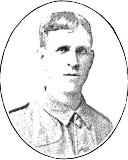
Samuel Green, Private, 25325, Essex Regiment. Samuel was born at St. Austell, Cornwall in 1878, the son of Thomas Green and Susannah Green (nee Hooper). He was lodging at 2, New Houses, Pant, Merthyr by 1901, where he had gained work as a steam engine cleaner. Samuel married Margaret Williams at Hirwaun in 1905 and by 1911 the couple had set up home at 12, New Street, Glynneath, whilst Samuel was lodging at Abercrave, where he worked as a colliery haulier. Samuel enlisted at Neath into the Middlesex Regiment soon after the outbreak of war. His wife, Margaret, then moved back to 21, Tramway, Hirwaun with their two children. Samuel was then posted to the 2nd (Garrison) Battalion, Essex Regiment following its formation in January 1916. Later that year the battalion embarked for India on garrison duties, remaining there for the remainder of the war. Samuel took ill whilst in India and was invalided aboard the New Zealand Hospital Ship Marama. Samuel died aboard Marama on 14 March 1918 and was buried at sea. The 40-year-old has no known grave but the sea, so is commemorated on the Hollybrook Memorial, Southampton, England.
Albert Harris, Private, 93968, Royal Welsh Fusiliers. Albert was born at Dinedor, Hereford in 1888, the son of Thomas Harris and Rosa Harris (nee Evans). The family had moved to 18, Station Street, Hirwaun by 1901. Albert was lodging at 10, Tudor Avenue, Hirwaun by 1911 and was working as a railway wagon painter. He married Ellen Tucker on 16 January 1915 and the couple set up home at 27, Crawshay Street, Hirwaun. Albert enlisted into the South Wales Borderers at Aberdare on 11 December 1915, stating a preference for home service. He was then placed on the Army Reserve and was not mobilised until 17 April 1918 when he attested at Brecon, before being posted to the 15th Battalion, South Wales Borderers at North Walsham for training. Albert was drafted to France in September 1918, initially to join the 10th Battalion, South Wales Borderers, but was instead posted to the 16th Battalion, Royal Welsh Fusiliers, which was attached to 113 Brigade, 38th (Welsh) Division, joining the battalion at Heudecourt on 1 October. By the time Albert joined the battalion, the division was making its way towards the Hindenburg Line, having began its offensive from positions north of Albert on 21 August, but had stopped to rest and rebuild prior to continuing its advance. On 4 October the 16th RWF moved into trenches at Lempire and took part in an assault on Mortho Wood soon afterwards before continuing the advance and reached Malincourt by 8 October. Over the coming days the division continued to advance, passing Le Cateau and reached positions south of the River Selle near Montay. Albert was killed during the crossing of the river Selle on 21 October 1918. The 30-year-old is buried in Montay Communal Cemetery, France.
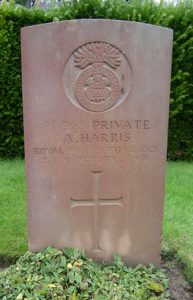
William Harts, Private, 12621, Welsh Regiment. David was born at Hirwaun in 1888 and was raised by his uncle, John Bevan, at 1, Edmund Street, Ystradfodwg. He had served with the Royal Garrison Artillery Militia and with the Welsh Regiment prior to marrying the widow Lydia Jane Rhodes (nee Pester) in 1905, and the couple set up home at 24, Williams Street, Pontarddulais. William was an Army Reservist and was mobilised at Swansea soon after the outbreak of war, re-joining the Regiment. William embarked for France on 30 November 1914, joining the 2nd Battalion, Welsh Regiment, which was near Richebourg, attached to 3 Brigade, 1st Division. The division had just moved there following terrible fighting at Ypres, where it had played a major role in stopping the Germans from capturing the strategically vital city and was rebuilding following severe losses. William was killed in action during an assault by 3 Brigade at Festubert on 21 December 1914. The 32-year-old has no known grave and is commemorated on the Le Touret Memorial, Richebourg L’Avoue, France. William is not commemorated on the Hirwaun war memorial.

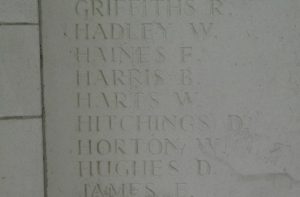
George Henry Hemmings, Lance Corporal, 12507, South Wales Borderers. George was born in Clapton, London in 1885, the son of John Hemmings and Eliza Alice Hemmings (nee Saunders). He left home to find work in South Wales and by 1911 was lodging at 8, Cwm Road, Argoed, where he worked as a colliery haulier. George had moved to Hirwaun prior to the war. He enlisted at Newport into the 4th Battalion, South Wales Borderers in August 1914. The battalion formed at Brecon, before moving to Park House Camp, near Tidworth to join 40 Brigade, 13th (Western) Division, then moved to billets in Cirencester before moving to Woking in March 1915 for final training. On 29 June 1915 the Division sailed from Avonmouth for Mudros, before landing at Cape Helles, Gallipoli on 15 July 1915. Two weeks later the Division was moved to Anzac, to reinforce the Australian and New Zealand troops there, in readiness for a great assault on the Sari Bair Ridge, in conjunction with fresh Allied landings at Suvla Bay. The assault began on 6 August 1915 and raged over the coming days. The 4th SWB reached the Achyl Dere before assaulting, and seizing Damakjelik Bair, one of the ridges held by the Turks. The Turks counter-attacked on 9 August and terrible fighting raged throughout the day. George was wounded during this terrible fighting at Gallipoli and was evacuated by Hospital Ship to Alexandria, where he was taken to the 19th General Hospital for treatment. He died of his wounds there on 24 August 1915. The 30-year-old was buried in Alexandria (Chatby) Military & War Memorial Cemetery, Egypt.
David John Holt, Gunner, 168597, Royal Field Artillery. David was born in Llwynypia on 4 November 1897, the son of John Holt and Annie Louisa Holt (nee Maidment). He had moved to 3, Cynon Place, Hirwaun prior to the war and had gained work as a collier. He enlisted into the Royal Field Artillery on 25 September 1915 and was posted to the 31st Division Ammunition Column, Royal Field Artillery. During December 1915 the Division moved to Egypt and took part in the defence of Suez Canal. In March 1916 it moved to France and saw its first major action at the Battle of Albert in July 1916. The Division took part in the assault on Serre, and suffered very high casualties, so was withdrawn for several months to rebuild. The division moved back into the line in November 1916 and took part in the Battle of the Ancre, and then wintered on the Ancre, until moving to Arras the following year. Here it fought at the Third Battle of the Scarpe and helped in the capture of Oppy Wood. David took ill during the summer of 1917 and returned to Britain, where he was transferred to the Labour Corps. He was then diagnosed as suffering from heart disease and was discharged from the army as medically unfit on 18 September 1917. David died of heart disease at Hirwaun on 5 April 1921, aged 23. David is not commemorated by the CWGC, nor is he commemorated on the Hirwaun war memorial.
William Daniel John, Private, S/21739, Queen’s Own Cameron Highlanders. William was born at Hirwaun in 1884, the son of William Bevan John and Elizabeth John (nee Jones). He left home as a young man to work as a locomotive engine cleaner at Caerphilly, then by 1911 was lodging at Holton Road, Barry, where he worked as a grocer’s assistant. William had moved to 7, Bridge Street, Bideford prior to the war and in 1915 married Emma Annie Welsford, whose father had been killed in South Africa during the Boer War. William enlisted at Inverness into the Queen’s Own Cameron Highlanders and after completing his training was drafted to France, joining the 7th Battalion, Cameron Highlanders, which was attached to 44 Brigade, 15th (Scottish) Division. The Division had landed in France during July 1915, and soon gained a reputation as one of the most formidable in the British Army, seeing its first major action during the Battle of Loos. The division wintered in the Loos sector, and in Spring 1916, the Division was involved in German gas attacks near Hulluch, and in the defence of the Kink position. In July the division moved to the Somme, taking part in the Battle of Pozieres, and then fought at Battle of Flers-Courcelette, where it captured Martinpuich. In October the division fought at the Battle of Le Transloy, and also in the Attacks on the Butte de Warlencourt. The division wintered on the Somme, in atrocious conditions. On 24 January 1917 the 7th Cameron Highlanders relieved the 6/7th Royal Scots Fusiliers in the front line to begin a routine tour in the trenches near Flers. William was one of eight men killed in action there on 28 January 1917. The 33-year-old has no known grave and is commemorated on the Thiepval Memorial, France.
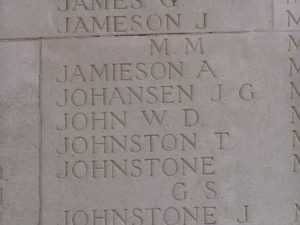
Gwilym Rhys Jones, Lieutenant, Royal Welsh Fusiliers. Gwilym was born in 1890, the son of William Jones and Catherine Jones (nee John), of Cefndon, Penderyn. He was educated in London, before beginning his career as a teacher at Hirwaun then moved to Park School Aberdare. He had been appointed headmaster of the Hook School, in Pembrokeshire, in March 1914. Gwilym originally enlisted into the 16th Battalion, Welsh Regiment, but was commissioned from the Welsh Regiment into the 6th Battalion, Royal Welsh Fusiliers on 19 March 1915. The battalion was attached to 158 Brigade, 53rd (Welsh) Division, and on 19 July 1915 sailed from Devonport for Imbros, before landing at C Beach, Suvla Bay, Gallipoli on 9 August 1915. 158 Brigade left the beach on the morning of 10 August 1915 and headed over the Salt Lake towards the Turkish positions at Scimitar Hill. The attack was muddled, and many men were caught in the open by shellfire and bullets. The survivors made their way to cover but had to remain wary of sniper fire if they moved. Gwilym was shot and killed while attempting to move forward with his men from a sheltered position and was later buried where he fell. The 25-year-old has no known grave, and is commemorated on the Helles Memorial, Gallipoli.
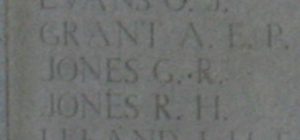
Ithel Jones, Private, STK/2161, Royal Fusiliers. Ithel was born in 1893, the son of Emrys Jones, headmaster of Hirwaun School, and Margaret Ann Jones (nee Davies), of 6, Harness Street, Hirwaun. His mother died in 1906, so young Ithel was sent away to be educated at Taunton School. Ithel then worked for Lloyd’s Bank as a as a bank clerk at Bargoed prior to the war. He enlisted at Bargoed into the army and was posted to the 12th Battalion, Royal Fusiliers, which was at South Downs attached to 73 Brigade, 24th Division. Ithel did not embark for France with the battalion when it left Britain in September 1915 but remained at home for several months before being drafted to France in the spring of 1916, joining the 10th (Stockbroker’s) Battalion, Royal Fusiliers. The battalion was attached to 111 Brigade, 37th Division and was on the Somme when Ithel arrived. The division took part in the diversionary attack on the Gommecourt Salient, during the first phase of the Battle of the Somme on 1 July 1916. Two of the Division’s infantry Brigades, the 111th and 112th, and the Divisional pioneers were then attached to the 34th Division, which had suffered very heavy losses in their attack on La Boiselle. Upon the Brigade’s returning to the 37th Division, it took part in the Battle of the Ancre. The division then moved in March 1917 and took part in the First Battle of the Scarpe, where it captured Monchy le Preux. The division then took part in the Second Battle of the Scarpe, and the Battle of Arleux before moving north to Ypres. Ithel came home for two weeks leave in July 1917, before returning to his battalion at Ypres. Here, the division fought throughout the Third Battle of Ypres, taking part in the Battle of the Menin Road, the Battle of Polygon Wood, the Battle of Broodeseinde, the Battle of Poelcapelle, the First Battle of Passchendaele and the Second Battle of Passchendaele. During March 1918 the Division was at the Somme, and fought during the German Offensive, following the German offensive which was launched on 21 March 1918. Ithel suffered terrible wounds from gas during the heavy fighting that ensued and after treatment in France was evacuated back to Britain. He died of the effects of his gas wounds at the Beaufort War Hospital, Bristol on 24 May 1918. The remains of the 24-year-old were brought home and he was buried in St. Cynog’s Churchyard, Penderyn.
John Samuel Jones, Private, 17770, King’s Own Yorkshire Light Infantry. John was born in 1891, the son of Howell Jones and Sarah Ann Jones (nee Todd), of 3a, Bethel Place, Hirwaun. He worked as a coal hewer prior to enlisting at Porth into the army and was posted to the 8th Battalion, King’s Own Yorkshire Light Infantry. The battalion formed at Pontefract in September 1914, moving to Frensham to join 70 Brigade, 23rd Division. In December 1914 the division moved to Aldershot, then continued its training at Hythe and Bordon before embarking for France in August 1915 and moving to positions near Erquinghem-la-Lys for trench initiation. On 18 October, 70 Brigade became attached to the 8th Division. During the summer of 1916 the division moved to the Somme sector, into positions near Henencourt Wood, southeast of Albert and began training for the forthcoming Somme offensive. On 29 June the division moved into positions near Authille Wood, and at 07.30 on 1 July 1916, following the explosion of a series of vast underground mines, launched an assault against the heavily defended village of Ovillers. John was killed in action during the assault across No Man’s Land that morning. The 25-year-old has no known grave and is commemorated on the Thiepval Memorial, France.
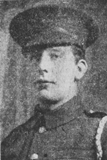
Sidney John Jones, Private, 352638, Manchester Regiment. Sidney was born at Wiveliscombe, Somerset in 1897, the son of William Jones and Laura Jones (nee Warman). The family had moved to Moynes Court, at Mathern, near Chepstow soon after the turn of the century, as William had gained the position of head gardener there. The family had moved again to 94, Brecon Road, Hirwaun prior to the war. Sidney enlisted into the army at Chepstow and was posted to the 2/9th Battalion, Manchester Regiment. The battalion had formed at Ashton-under-Lyne in August 1914, before joining 198 Brigade, 66th (East Lancs) Division. In March 1916 the division moved to Colchester, then in February 1917 landed in France, moving to the Cuinchy Sector for trench initiation and training. The division remained in this area until it was transferred to the Channel Coast, moving to Bray Dunes by 3 June 1917 before taking over positions in the Nieuport Sector. The Allies had planned for a possible offensive along the coast, if the forthcoming Passchendaele offensive was successful, but following the failure of the latter the coastal offensive was called off and at the end of September 1917 the 66th Division was transferred into the Ypres Salient, to join the great fight for Passchendaele Ridge. On 6 October the division reached the junction of the Ypres to Zonnebeke and the Ypres to Menin roads, before moving into positions on Frezenberg Ridge on the evening of 8 October. On the following morning, 9 October 1917, the division launched an assault from its new positions upon the German positions around Heine House. Sidney was killed in action during the assault that day. The 20-year-old has no known grave and is commemorated on the Tyne Cot Memorial, Belgium. Sidney is not commemorated on the Hirwaun war memorial.
Thomas Jones, Private, 15640, Royal Welsh Fusiliers. Thomas was born at Caio, near Llandovery, in 1891 the son of Thomas Jones and Margaret Jones (nee Richards). Prior to the war his father had died, and Margaret had remarried, moving the family to 8, Challis Row, Hirwaun, Glam. Thomas enlisted at Hirwaun into the 10th Battalion, Royal Welsh Fusiliers soon after the outbreak of war. The battalion was attached to 76 Brigade, 25th Division and embarked for France on 27 September 1915. Two weeks later, 76 Brigade transferred to the 3rd Division, which was holding the line at St. Eloi, near Ypres. The Division saw heavy fighting during the Actions of the Bluff in February 1916 and then at the Actions of the St Eloi Craters from 27 March to 16 April. Arthur probably joined the 10th RWF after one of these actions, due to heavy losses suffered by the battalion. The battalion continued to suffer during these months at St. Eloi, coming under a gas attack for the first time on 29/30 April. By the middle of June, the Division had moved out of the Ypres Salient to billets around Eperlecques, where intense training was carried out prior to moving to the Somme sector by 2 July. The main Somme offensive had opened on the previous day, and the 3rd Division was ready to enter the fray, bivouacking at Bronfay Farm by 9 July and on 13 July moved into the captured German lines at Montauban Alley. The 10th RWF took part in heavy fighting over the coming days, and on 19 July received orders for an assault on Delville Wood. Just after midnight the following day the battalion moved forwards and became caught in in terrible fighting within the wood, the fighting of such severity that two men of the battalion were awarded the Victoria Cross. On 25 July the shattered battalion was relieved and moved into reserve and did not move back into the line until 17 August, when the battalion attacked Lonely Trench. Thomas was posted as missing during the attack that day and was later deemed to have been killed in action at some time between 16-19 August 1916. His remains were found buried on the battlefield in May 1926, together with a number of other soldiers. Thomas was the only man identified, due to his ID disc, which had survived the ten years buried. The remains of the 24-year-old were then re-interred in A.I.F. Burial Ground, Flers, France.
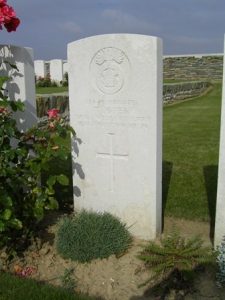
Henry Lewis, Private, 76673, Welsh Regiment. Henry was born in 1897, the son of Morgan John Lewis and Sophia Lewis, of 7, Merthyr Road, Hirwain. He worked as a collier prior to enlisting into the Training Reserve at Aberdare on 11 January 1916 and was placed on the Army Reserve, due to his occupation. Henry was mobilised on 27 April 1918 due to the heavy casualties being suffered in France and was posted to the 3rd Battalion, Welsh Regiment at Redcar for training. He embarked for France on 14 September 1918, joining the Infantry Base Depot at Rouen, and on 18 September was posted to the 15th Battalion, Welsh Regiment. The battalion, known as the Carmarthen Pals battalion, was attached to 114 Brigade, 38th (Welsh) Division. The division was in the process of advancing from its summer positions on the Somme, following the launching of the great offensive on 21 August and had rapidly recaptured the old Somme battlefields of 1916 whilst heading towards the Hindenburg Line. Henry joined the 15th Welsh near Gouzeaucourt, just after its part in the capture of the heavily defended town, following a successful assault on Gauche Wood. The battalion then had a short spell in reserve north of Equancourt before moving to positions at Lechelles, a small village slightly north of Equancourt, and west of Havrincourt Wood. The Allies were by now in striking range of the Hindenburg Line and the 38th Division was put into reserve whilst the Australians and Americans assaulted the Hindenburg Line in their sector, near Bony. Following the breaching of the line the 38th Division advanced through their tired Allies and continued the offensive, tasked with the clearing of Mortho Wood and the capture of Villers-Outréaux, both of which fell on 8 October after terrible fighting. Henry was killed during the fighting around Mortho Wood that day. The 22-year-old is buried in Prospect Hill Cemetery, Gouy, France.
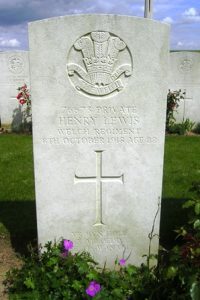
George Pearce Llewellyn, Private, 21671, South Wales Borderers. George was born at Cardiff on 14 February 1890, the son of John Llewellyn and Rachel Llewellyn (nee Morris). His father died when he was young, and George went into the Union Workhouse at Cardiff with his mother Rachel on 16 June 1896. By 1901 George was lodging with his mother at 65, Salt Mead Road, Canton, where he began work for the Great Western Railway as a cleaner at Cardiff Station, but by 1911 he was lodging with his elder brother Fred at 8, Stable Cottage, Cwmgwrach, where he was working as a colliery labourer. George had moved to 4, Tudor Avenue, Hirwaun in about 1912 and in the spring of 1913 married Harriet Drew. He enlisted into the 11th Battalion, South Wales Borderers at Aberdare soon after the outbreak of war and joined the battalion at Colwyn Bay, where it was attached to the 43rd (Welsh) Division. The Division trained in North Wales before moving to Winchester in the summer of 1915, where the formation became renumbered 115 Brigade, 38th (Welsh) Division. The Division began moving to France on 2 December 1915 and moved to the Nursery Sector near Fleurbaix for trench initiation alongside the Guards Division. The Division then held a sector of the line near Cuinchy before marching south to the Somme sector in June 1916 to take part in the assault on Mametz Wood. The first attack on the wood was launched on a two-battalion front on 7 July, but failed, and the Divisional Commander, Sir Ivor Philipps, was replaced before the Division attacked again on a two Brigade front on 10 July 1916. After two days of ferocious hand-to-hand fighting, the wood was cleared up to its northern edge, before the battered Division was relieved. George had been wounded during the initial assault on Mametz Wood and was evacuated to hospital at Rouen, where he died of his wounds on 15 July 1916. The 26-year-old is buried in St. Sever Cemetery, Rouen, France.
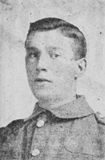
Albert Mallett, Lance Corporal, 46607, Welsh Regiment. Albert was born in 1895, the son of Henry Thomas Mallett and Catherine Mallett (nee Richards), of 10, Gamblyn Street, Hirwaun. He worked as a collier prior to enlisting at Aberdare into the 10th Battalion, Royal Welsh Fusiliers in the spring of 1915. The battalion was at Codford St. Mary, attached to 76 Brigade, 25th Division when Albert joined it. The division embarked for France on 27 September 1915 and moved to positions at St. Eloi, near Ypres. The Division saw heavy fighting during the Actions of the Bluff in February 1916 and then at the Actions of the St Eloi Craters from 27 March to 16 April. Arthur probably joined the 10th RWF after one of these actions, due to heavy losses suffered by the battalion. The battalion continued to suffer during these months at St. Eloi, coming under a gas attack for the first time on 29/30 April. By the middle of June, the Division had moved out of the Ypres Salient to billets around Eperlecques, where intense training was carried out prior to moving to the Somme sector by 2 July. The main Somme offensive had opened on the previous day, and the 3rd Division was ready to enter the fray, bivouacking at Bronfay Farm by 9 July and on 13 July moved into the captured German lines at Montauban Alley. The 10th RWF took part in heavy fighting over the coming days, and on 19 July received orders for an assault on Delville Wood. Just after midnight the following day the battalion moved forwards and became caught in in terrible fighting within the wood, the fighting of such severity that two men of the battalion were awarded the Victoria Cross. On 25 July the shattered battalion was relieved and moved into reserve and did not move back into the line until 17 August, when the battalion attacked Lonely Trench. On 23 August the Division moved out of the line to rest and moved to Noeux-les-Mines, near Loos. After a month there, the Division moved back into a rest area for further training before moving back south to the Somme and by 12 November took over trenches at Serre. On the following day, 13 November 1916, the Division launched an assault against the German positions at Serre. The 10th RWF reached Serre village, but the flanking battalions failed to keep up, and heavy losses were suffered, with almost 300 officers and men killed, wounded, or missing. Albert was probably wounded during this time as he was subsequently transferred to the 17th Battalion, Welsh Regiment, which was attached to 119 Brigade, 40th (Bantam) Division. Late in 1916 the Division had moved south to the Somme, and fought at the Battle of the Ancre, before remaining in the sector over the winter. In March 1917 the Germans withdrew to their shortened line, called the Hindenburg Line, and the 40th Division was among the units which followed the withdrawal. Later in the year the Division took part in the Battle of Cambrai and launched an attack on Bourlon Wood on 23 November 1917. The attack was carried out by 119 Brigade, led by the 12th SWB and 19th RWF. The 17th Welsh was in support for the initial assault, but was soon ordered to advance, to support the two attacking battalions. Heavy fighting raged within the wood over the coming days, with the 18th Welsh also being thrown forwards into the fight, and the Division suffered terribly. Albert was killed within Bourlon Wood on 25 November 1917. The 21-year-old has no known grave and is commemorated on the Cambrai Memorial, Louverval, France.
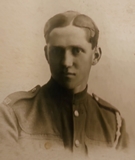
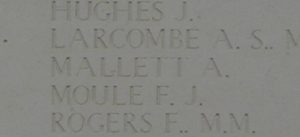
Albert Matthews, Private, 40614, Royal Welsh Fusiliers. Albert was born in Dowlais in 1896, the son of George Edward Matthews and Jane Matthews (nee Jones). His parents died when he was young, so Albert and two of his brothers were sent to the Glamorgan Workhouse. Upon leaving the workhouse in around 1912, Albert went to live at Cefn-y-Don Farm, Hirwaun and found work as a labourer for the Brecon & Merthyr Tydfil Junction Railway. He enlisted into the Royal Welsh Fusiliers in March 1916 and was posted to Kinmel Park for training. The camp, just south of Bodelwyddan, was built in 1915 and used for training new recruits and served mostly Welsh and Border regiments. Albert had only been at Kinmel for two weeks when he took ill and died in hospital at Bangor an hour after being admitted on 12 April 1916. The 20-year-old was buried with full military honours in Glanadda Cemetery, Bangor.
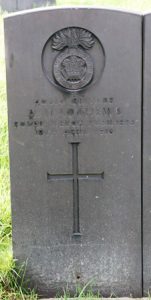
Alfred Morgan, MC, Second Lieutenant, South Wales Borderers. Alfred was born in 1883, the son of Edward Morgan and Margaret Morgan, of Hirwaun. He was educated at Aberystwyth University and then medicine at Cardiff University, becoming well known in both for his skills as an athlete and was a highly regarded footballer and rugby player. He captained the cricket and football teams at Aberystwyth whilst there, and played rugby for Aberdare and Caerphilly, before signing for Swinton rugby league team, as a professional player. He enlisted into the 19th Hussars, a cavalry unit, soon after the outbreak of war, and embarked for France on 8 June 1915, serving with the 19th Hussars and 11th Hussars, before gaining a commission as Second Lieutenant into the South Wales Borderers on 23 October 1917. Returning to Britain for his officer training, Alfred was then drafted back out to France to join the 10th Battalion, South Wales Borderers. The battalion was attached to 115 Brigade, 38th (Welsh) Division and by the time Alfred joined it, was holding a section of the line in front of Armentieres. Alfred led out a trench raid against the enemy salient facing the battalions’ positions in the Wez Macquart Sector on 28 March 1918, which resulted in some 25 Germans killed and six captured and brought back for questioning. For his gallantry during the raid, he was awarded the Military Cross: ‘For conspicuous gallantry and devotion to duty. During a raid on the enemy’s trenches, he was in charge of a clearing party, which he led through the hostile wire into the trench under heavy machine-gun fire. He, together with two men, attacked a hostile post, in which five of the enemy were killed and two captured, and afterwards entered a dug-out, the occupants of which they killed. His courage and fine leadership were most conspicuous.’ Soon afterwards the division was relieved and moved to positions north of Albert, at Bouzincourt Ridge, relieving the battered 2nd and 47th Divisions. After a short period behind the line at Toutencourt then Warloy-Baillon, the 10th SWB moved into support positions facing Bouzincourt Ridge on 16 April, where the men working on improving bivouac positions. On 25 April the battalion moved into the front line to begin its first tour in the trenches in this new sector. Alfred was mortally wounded by German artillery fire here on 28 April 1918 and died of his wounds that same day. The 35-year-old was buried in Varennes Military Cemetery, France.
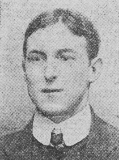
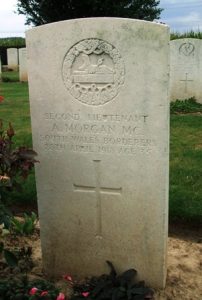
Morgan Morgans, Private, 15954, Royal Welsh Fusiliers. Morgan was born at Hirwaun Road, Gadlys in 1887, the son of Thomas Morgans and Margaret Morgans (nee Davies). The family had moved to Tanycoed, Glynneath prior to the war and Morgan had worked there for several years at the Pwllfaron Colliery. He enlisted into the 9th Battalion, Royal Welsh Fusiliers soon after the outbreak of war, under the alias of William Jones. The battalion had formed at Wrexham in September 1914, before moving to Tidworth to join 58 Brigade, 19th (Western) Division. On 19 July 1915 Evan landed in France with the battalion, and the entire 19th Division then moved to the Nursery Sector at Calonne for trench initiation alongside the Dehra Dun Brigade. The infantry battalions of the division then began carrying out the usual routines of rotating in the trenches: four days in the front line; four in support; and four in reserve, interspersed with training regimes and carrying out working parties and trench raids. Just south, the British launched a great offensive around the town of Loos on 25 September 1915, and the 19th Division was ordered to attack from its positions at the same time, to attempt to draw enemy attention away from the main battle area. The attacking battalions of the 19th Division were in place by 04.00, and then at 05.50 the men climbed out of their trenches to launch their assault, behind a gas and smoke screen. The assault was a disaster, and heavy casualties were suffered by the 19th Division for no gain. The Division wintered on the Somme and in February followed the German withdrawal to the Hindenburg Line. During the middle of March 1917, the Division was relieved from the line and began to move north, taking over positions in the Ypres Salient, and on 7 June took part in the assault on Messines Ridge, which was famously preceded by the blowing of a series of 19 huge underground mines. The 19th Division saw heavy fighting during the battle, then on 15 June Morgan, who had served as a stretcher bearer with the battalion since landing in France and would have seen untold horrors, deserted and made his way back home, where he told his family he had been wounded. He then made his way to Bristol where he surrendered to the authorities on 4 September and was brought back to Flanders for a court martial. He was found guilty of desertion and was shot on Kemmel Hill on 25 October 1917. The 27-year-old was buried in Locre Hospice Cemetery, Belgium. He was among those soldiers pardoned by the British Government in 2006.
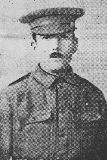
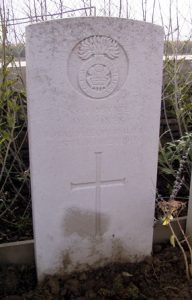
James North. James cannot presently be identified.
Hubert Edgar Nunn, Lance Corporal, Deal/378(S), Royal Marines. Hubert was born in Kent on 18 February 1891, the son of Albert Edgar Nunn, a Civil Engineer, and Frances Ellen Nunn (nee Turner), of Woodbury, Tenderden. Both Hubert and his brother Reginald followed in their father’s footsteps and trained as Civil Engineers at Brighton College. Their father had gained the contract to build the Rhondda Waterworks, so the entire family moved to Hirwain by 1909. Tragically the following year, whilst on holiday in Norfolk, the boy’s mother shot and killed their father in a fit of jealousy before killing herself at the Cliftonville Hotel in Cromer on 17 July 1910. Both Hubert and Reginald remained at Hirwain to continue their work and both men enlisted into the Royal Marine Engineers on 1 October 1914, following the outbreak of war. After completing his training, Hubert was posted to the Royal Marine Division Engineers. The Naval Brigades were originally sent to Antwerp and Dunkirk in September and October 1914 to guard against invasion by the Germans. However, Antwerp fell to the Germans soon after, and so many of the RND units were withdrawn to England. After a lengthy period of refit and training the Division moved to Egypt preparatory to the Gallipoli campaign. Landing on 25 April 1915, the Division fought throughout the Campaign on Gallipoli. Hubert was killed at Gallipoli during a day of heavy fighting on 23 June 1915. The 24-year-old was buried in Skew Bridge Cemetery, Gallipoli. His brother Reginald survived the war but was killed in Singapore in WW2.
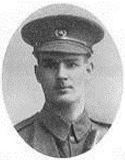
Samuel Alexandra Paget, Private, 52008, Royal Irish Fusiliers. Samuel was born in Somerset in 1883. He married Alice Maud Crowden at Bridgwater on 7 June 1914 and the couple moved to 1, Brecon Road, Hirwain where their only child, Samuel, was born. Samuel enlisted into the 2/18th Battalion, London Regiment in 1916. The battalion was attached to the 60th (London) Division and had moved from Ireland in May 1916, before being despatched to France. In November 1916 the Division moved to Salonika, via Marseille and Malta, completing assembly on Christmas Day 1916 and remained here until June 1917 when it began moving to Egypt, to join the EEF for the campaign in Palestine. The division then took part in the Third Battle of Gaza, between 30 October to 7 November 1917, which saw the Turkish defences broken, and then joined the great advance of the EEF northwards through Palestine, before taking part in the capture of Jerusalem. The division remained in Palestine over the coming months, helping drive the Turks out of the country which had been under ottoman rule for hundreds of years. Samuel’s wife, Alice, died at Hirwain on 19 November 1918, just a week after the Armistice. As a result, Samuel volunteered to continue to serve in the army after the war, transferring to the 2nd Battalion, Royal Irish Fusiliers after returning to Britain. Samuel died in Aldershot Military Hospital on 25 July 1919. The 36-year-old was buried in Aldershot Military Cemetery, Hampshire.
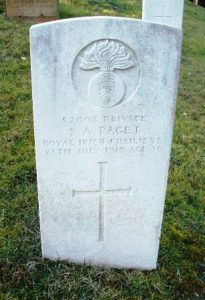
David George Phillips, Private, 4666, Royal Welsh Fusiliers. David was born in Hirwain in 1891, the son of Rees Phillips and Sarah Ann Phillips (nee Barker). He moved to Pentre to work as a coalminer as a young man. David enlisted into the Royal Welsh Fusiliers at Pontypridd on 9 April 1912, and married Jennett Jones at Porth whilst on leave on 29 December 1913. David served with the 3rd Battalion, Royal Welsh Fusiliers on home service over the coming years, but on 11 November 1914 was drafted to France to join the 1st Battalion, Royal Welsh Fusiliers, which was holding the line near Neuve-Chapelle, attached to 22 Brigade, 7th Division. On 10 March 1915 the 7th Division took part in the disastrous Battle of Neuve Chapelle, which lasted three days for little or no gain. The 1st RWF then moved to billets at Fort D’Esquin, where it enjoyed several weeks rest behind the lines. By 7 April the 1st RWF had moved to reserve billets at Rue du Bacquerot, and four days later relieved the Royal Scots in the trenches to begin a routine tour in the line, being relieved on 14 April. The battalion enjoyed another period out of the line until 6 May, when it moved forwards again, to take part in the Battle of Aubers Ridge, where the Division launched an assault against the village of Aubers on 9 May 1915. The 1st RWF remained in the assembly trenches, in support of the assault, but the attacking troops made no gains, so the battalion was not called upon, and marched to billets in Essars. On 15 May 1915 the 7th Division took part in another assault, against the village of Festubert. The 1st RWF moved from its billets at Essars that day, marching via Bethune to its starting positions at Rue Cailloux, and at dawn on 16 May 1915 launched its assault on the German line’s opposite, ordered to seize the line running from the Rue Quinque to Rue D’Ouvert. The battalion swept through the German front and 2nd lines, before becoming held up, suffering very heavy casualties. David was killed in action here on 16 May 1915. The 24-year-old has no known grave and is commemorated on the Le Touret Memorial, Richebourg-L’avoue, France. David is not commemorated on the Hirwaun war memorial.
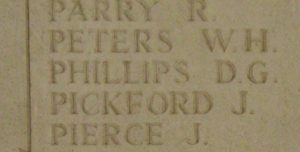
James Phillips, Private, 28027, Welsh Regiment. James was born in 1888, the son of Richard Phillips and Margaret Phillips (nee Gregory), of Penywain, Hirwaun. His parents died when he was young, so James was raised by relative at 4, Primrose Hill, Trecynon, where he later gained work at the Bwlfa Colliery. He enlisted at Aberdare into the 18th Battalion, Welsh Regiment during the spring of 1915. The battalion had been raised in January 1915 as a Bantam Battalion, made up of men of below average height, and initially went to Porthcawl attached to the 43rd (Welsh) Division. During July 1915 the battalion moved to Prees Heath to join 119 Brigade, 40th (Bantam) Division and landed in France with the Division in June 1916. The Division moved to positions around Lillers before taking over the North Maroc Sector, near Loos, for trench initiation and once acclimatised was left to hold the sector itself over the coming months. The infantry battalions of the Division then began the usual routines of rotating for duty in the trenches: normally four days in the front line; four in support and four in reserve. Late in 1916 the Division moved south to the Somme, and fought at the Battle of the Ancre, before remaining in the sector over the winter. In March 1917 the Germans withdrew to their shortened line, called the Hindenburg Line, and the 40th Division was among the units which followed the withdrawal, taking over new positions at Villers-Plouich. The 18th Welsh were holding the front line here on 18 September 1917 when William was accidentally wounded whilst on wiring duty. He was evacuated to a nearby Field Ambulance where he died of his injuries that same day. The 28-year-old was buried in Fins New British Cemetery, Sorel-Le-Grand, France. James is not commemorated on the Hirwaun war memorial.
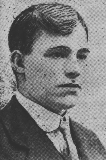
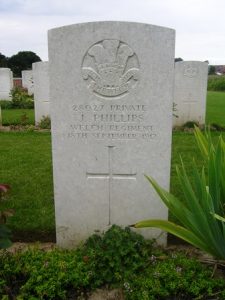
George Hopkin Powell, Private, 58370, Welsh Regiment. George was born in 1899, the son of Rees Powell and Sarah Powell (nee Hopkins), of 2, Railway Terrace, Hirwaun. He worked as a colliery fitter prior to enlisting into the 3rd Battalion, South Wales Borderers at Cardiff on 24 April 1918 and was posted to Brecon for training. George was drafted to France on 1 September and was transferred from the Infantry Base Depot to the 13th Battalion, Welsh Regiment. The battalion was attached to 114 Brigade, 38th (Welsh) Division, which was taking part in the advance towards the Hindenburg Line, following the launching of its offensive from positions north of Albert the previous month. George joined the battalion in positions near Sailly-Saillisel, which the division had recently captured. He probably arrived in time to take part in the crossing of the Canal du Nord by the division on 5 September. The 13th Welsh then enjoyed a brief rest before re-joining the offensive on 11 September and two days later defended the divisions positions following a German counterattack. The division then continued the advance, heading towards Gouzeaucourt and took over the old Heather Trench and Heather Support, prior to launching an assault against the outer Hindenburg Line defences on 18 September. George was wounded during the heavy fighting that day and was evacuated to the 43rd Casualty Clearing Station where he died of his wounds on the following day, 19 September 1918. The 21-year-old was buried in Thilloy Road Cemetery, Beaulencourt, France.
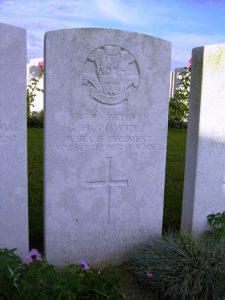
David Price, Private, 76650, Welsh Regiment. David was born in 1898, the son of William Price and Elizabeth Price (nee Williams), of Tirgwynbach Cottage, Hirwaun. He worked as a collier prior to enlisting into the 114th Battalion, Training Reserve at Cardiff on 26 April 1918 and was posted to Clipstone Camp for training. David was subsequently posted to the 3rd Battalion, Welsh Regiment at Redcar, before being drafted to France on 14 September 1918. He then spent a brief time at the Infantry base Depot at Rouen before being posted to the 15th Battalion, Welsh Regiment on 18 September. The battalion, known as the Carmarthen Pals battalion, had recruited heavily in west Wales before joining 114 Brigade, 38th (Welsh) Division. Upon his arrival with the battalion, David was posted to D Company. The battalion was at Heather Trench, near Gouzeaucourt, when David arrived, having spent the previous month rapidly advancing along the old Somme battlefields of 1916. The battalion moved into reserve at Equancourt soon after, before moving on 28 September to positions at Fins Ridge Wood in brigade reserve, near the Village of Lechelles. The Hindenburg Line had now been reached and was about to be assaulted by the British Fourth Army south of Bony, then the Americans would continue the advance. The 38th (Welsh) Division was in reserve, as the Hindenburg Line was smashed at Bony and Bellicourt, then on 4 October, the division was ordered forward, crossing the canal at Bony and taking up positions in the ruined village of Aubencheul, west of Villers-Outréaux. The divisions task was to clear the heavily defended Mortho Wood. The plan was for both 113 and 115 Brigades to make the initial assault on the night of 7 October 1918, clear Mortho Wood, and hold the ground taken. In the morning of 8 October, 114 Brigade was to advance. The 13th Welsh were on the right, with the 15th Welsh on the left, with orders to pass each side of Malincourt. The 14th Welsh, with four tanks, were detailed to mop up the German defenders of Mortho Wood, and the attack was to push on, with the 15th Welsh tasked with gaining and holding the high ground at Gard Wood. David was badly wounded during this assault on 8 October, suffering gunshot wounds to his left leg, and was evacuated to the 3rd Canadian Casualty Clearing Station. After having his wounds dressed, David was sent by ambulance train to No 3 Stationary Hospital at Rouen, where his leg was amputated. David died there of his wounds on 13 October 1918. The 20-year-old was buried in St. Sever Cemetery Extension, Rouen, France.
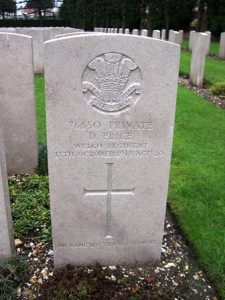
David John Price, Private, 1916, Welsh Regiment. David was born in 1894, the son of Daniel price and Elizabeth Price (nee Lewis), of 12, Bankes Street, Maesydre. Following the death of his father in 1899, David went to live with his uncle, William Lewis, at 23, Weatheral Street, whilst his mother moved to 2, Wind Street, Hirwaun. David enlisted into the 5th Battalion, Welsh Regiment at Aberdare soon after the outbreak of war. The battalion was the local Territorial unit and mobilised for war at Pontypridd in August 1914, as part of South Wales Brigade, Welsh Division and moved to Tunbridge Wells until the end of the month, before moving to Scotland to man the Forth and Tay Defences. On 17 April 1915 the battalion moved to Bedford, joining 158 Brigade, 53rd (Welsh) Division. On 19 July 1915 the entire Division sailed from Devonport for Imbros and on 9 August 1915 landed at Suvla Bay. The infantry moved off the beaches across the Salt Lake, under shellfire, into the scrub covered Chocolate Hill, but due to a lack of maps and no knowledge of the terrain, many of the units became disorientated, and the situation became chaotic. David was killed in action a week later, on 17 August 1915. The 20-year-old has no known grave and is commemorated on the Helles Memorial, Gallipoli. (The Hirwaun war memorial shows David G. Price, but this is most likely the correct man).
Roger Price, Private, 130542, Machine Gun Corps. Roger was born in 1896, the son of Roger Price and Mary Anne Price (nee Williams), of 7, John’s Row, Hirwaun. He worked as a hawker prior to the war. Roger enlisted into the South Wales Borderers at Cefn Coed in the summer of 1916 and trained as a specialist machine-gunner. Roger was then posted to the 61st Battalion, Machine Gun Corps. The battalion started life as the 267th Machine Gun Company, before embarking for France at Southampton on 13 January 1918, moving to positions at Foreste. At the end of February, the company became the 61st Battalion, Machine Gun Corps, joining the 61st (South Midland) Division at Vaux, in the Somme valley, where it was holding the forward zone of defences in the sector northwest of Saint Quentin, in the area of Ham. At dawn on 21 March 1918 the Germans launched a large-scale offensive along the section of Western Front running south from Croisilles to La Fère, and the 61st Division was hit hard by three enemy Divisions. The division put up a stubborn defence but was forced to withdraw on the afternoon of 22 March, in consequence of the enemy’s progress at other parts of the line. After suffering heavy casualties, the depleted Division was moved to Flanders to rest, but the Germans launched the second phase of their offensive here just weeks later, on 9 April 1918, and the Division became caught up in the thick of the action again, during the withdrawal to Éstaires, helping defend the vital town of Bethune. The Germans switched their attention to the Champagne region in May, so the division took over the St. Venant Sector over the coming months. On 21 August 1918 the Allies launched a general offensive along the Somme front. The 61st Division had by now gone out of the line to train, but at the beginning of September moved back into positions near La Gorgue, ready for the Allies to launch another offensive in Flanders. Roger was killed early in the advance, during heavy fighting for Rue Bataille on 7 September 1918. The 22-year-old is buried in Ration Farm Military Cemetery, La Chapelle-D’Armentieres, France.
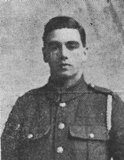
George Ernest Richards, Private, 27294, Leicestershire Regiment. George was born at 28, Bethel Place, Hirwain in 1893, the son of George Richards and Caroline Richards (nee Jones). He was baptised at St. John’s Church on 7 April 1893. By 1901 the family had moved to Brooksby House, Leicester, where George’s father had gained work as a boiler stoker. George trained as a professional dancer after leaving school and by the time that war erupted, was lodging at Windmill Hill House, Motherwell. He enlisted into the 12th Battalion, Leicestershire Regiment at Motherwell on 24 February 1916 and was placed on the army reserve for two months before being mobilised. George embarked for France on 18 July 1916 and was posted to the 8th Battalion, Leicestershire Regiment, which was attached to 110 Brigade, 21st Division and joined the battalion at Roclincourt. At the beginning of September, the 21st Division was relieved and moved south to join the great Somme offensive, reaching Trônes Wood by 17 September. The 8th Leicester’s remained here in reserve for a week, before advancing to assembly positions near Flers on the night of 24 September, then at 12.30 on 25 September 1916 took part in an assault against the German first line trench system, some 1,000 yards in front. George was killed in action during the assault that day. The 24-year-old has no known grave and is commemorated on the Thiepval Memorial, France. George is not commemorated on the Hirwaun war memorial.
William Herbert Ringrose, Private, 3474, Welsh Regiment. William was born in Peterborough in 1868, the son of William Ringrose and Eveline Ringrose (nee Harker). William left home as a young man and enlisted into the Bedfordshire Regiment in 1888. He appears to have served overseas for several years but had returned to England by 1896 and had left the army, as he married Gertrude Emily Adams on 6 July 1896. Over the years the couple had at least seven children. By the time war erupted, the family was lodging at 27, Tramway, Hirwaun with Mrs Catherine Tyler. William re-enlisted into the army at Pontypridd, joining the 3/5th Battalion, Welsh Regiment. He embarked for the Mediterranean in August 1915 and landed at Gallipoli on 2 September, joining the 1/5th Battalion, Welsh Regiment, which was attached to 158 Brigade, 53rd (Welsh) Division. The division had suffered severe casualties during the preceding weeks, following its landing at Suvla Bay the previous month, and was in positions near Chocolate Hill when William arrived. The Division remained here throughout the coming months and suffered severe losses in manpower strength during the great November 1915 blizzard on Gallipoli, when its total strength was reduced to less than that of a full-strength Brigade. William was killed in action here on 13 November 1915. The 46-year-old was buried in Lala Baba Cemetery, Gallipoli. Sadly, his wife had died 5 November 1914, leaving their children orphaned. William is not commemorated on the Hirwaun war memorial.
John Henry Roberts, Private, 52483, Royal Army Medical Corps. John was the son of Thomas and Martha Roberts of 1, Frolic Street, Newtown. He married Mary Emma Roberts, a farm servant from Montford Bridge, in 1906 and by 1911 the couple were living at Penderyn, where John was working as a railway platelayer. He enlisted at Brecon into the Royal Army Medical Corps soon after the outbreak of war and on 21 June 1915 was posted aboard the Hospital Ship SS Galeka. The ship had been requisitioned from the Union-Castle Line by the Admiralty and was initially used as a troop transport before being converted into a Hospital Ship with accommodation for 366 wounded passengers. On 28 October 1916 Galeka was entering Le Havre to collect wounded men from the Somme offensive when she struck a mine which had been laid by the German submarine UC-26 and sank with the loss of 19 RAMC personnel. John was 35 years old when he drowned in the sinking of Galeka. He is commemorated on the Galeka Memorial in Ste. Marie Cemetery, Le Havre, France.
Evan John Roderick, Private, 19239, York and Lancaster Regiment. Evan was born on 14 April 1882, the son of Daniel Roderick and Ann Roderick (nee Bryant), of 2, John’s Street, Hirwaun. Evan gained a position working for the Great Western Railway at Aberdare after leaving school and continued to work for the company over the coming years. He enlisted into the York and Lancaster Regiment at Cardiff on 8 September 1914 and was posted to the 9th Battalion, York and Lancaster Regiment. The battalion had formed at Pontefract in September 1914, moving to Frensham to join 70 Brigade, 23rd Division. The division then moved to Bordon to complete its training before embarking for France and landed at Boulogne on 27 August 1915. The division concentrated around Tilques before taking up positions in front of Armentieres, for trench initiation in the Nursery Sector near Fleurbaix. The division was relieved in March 1916 and began the move south to the Somme sector, reaching Vignacourt by 27 March. By the end of the month the division had taken up billets in Albert before taking over the front-line positions east of the town, where it began to prepare for the forthcoming Somme offensive. During the final days leading up to the battle, Evan’s battalion rested behind the lines, watching the almost constant artillery bombardment of the German trenches, then at 06.20 on 1 July 1916, following the explosion of a series of vast underground mines beneath key German positions, his battalion launched a frontal attack against the village of Contalmaison. Evan was killed in action that day, the first day of the Battle of the Somme. The 34-year-old has no known grave and is commemorated on the Thiepval Memorial, France.
Maurice Sewell, Private, 35021, Duke of Wellington’s (West Riding Regiment). Maurice was born at Marple, Cheshire on 13 March 1900, the son of John Sewell and Charlotte Sewell (nee Buckby). His parents had both died by 1911, so Maurice and some of his siblings were living at The Bungalow, Rhigos, with their sister, Fanny Hoffland, and her husband. Just prior to the war, Maurice and an elder brother, Jack, moved from Rhigos and lodged at 7, Back Albion Street, Dewsbury, where they had found work as colliers. Maurice enlisted at Pontefract into the 4th Battalion, East Yorkshire Regiment on 18 January 1916 and was placed on the army reserve. He was mobilised on 16 January 1918 and transferred to the Durham Light Infantry. On 4 August 1918 Maurice was drafted to France and was transferred to the 9th Battalion, Duke of Wellington’s (West Riding Regiment). The battalion was in the Somme Valley, taking part in the great Allied offensive which had just been launched. Over the coming days the division drove across the southern edge of the old Somme battlefields of 1916, in conjunction with the 38th (Welsh) Division, and by the end of August had reached Le Transloy. Maurice joined the battalion here on 1 September. He then took part in the continued advance towards the Canal du Nord and following the crossing of this great line the division maintained its advance towards the Hindenburg Line, reaching positions facing Gouzeaucourt by 18 September before taking part in the capture of the heavily defended town. Maurice’s battalion was then relieved and moved back to positions near Lesboeufs to rest. On 26 September Maurice was in camp there when his platoon was ordered to fall in. As the men stood to, one of his comrades dropped his rifle, which went off and shot Maurice through the chest. He was evacuated to the 43rd Casualty Clearing Station for treatment, but sadly died of his injuries there two days later, on 28 September 1918. The 18-year-old was buried in Thilloy Road Cemetery, Beaulencourt, France.
Joseph Shannon, Sergeant, 67470, Royal Engineers. Joseph was born in 1867, the son of Edward Shannon and Mary Emma Shannon (nee Ward), of Aberdare. He married Sarah Ann Thomas at Hirwaun on 30 March 1891 and the couple set up home at 17, Brecon Road, Hirwaun, where their five children were born. Joseph had worked as a plasterer for many years prior to the war. He enlisted at Aberdare into the Royal Engineers and was drafted to France in 1916, joining the 24th Base Park Company, Royal Engineers. Joseph had served on the Western Front for just over two years when he took ill and was sent to hospital at Blargies. He died there of pneumonia on 4 November 1918, just a week before the Armistice. The 52-year-old was buried in Blargies Communal Cemetery Extension, France.
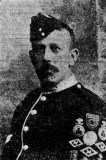
William Smith, Lance Corporal, 7971, South Wales Borderers. William was born at Bedminster in 1886, the son of Daniel Smith. He had moved to South Wales to find work as a young man and on 17 November 1909 married Theresa Mary Sedgmoor at Neath Registry Office. The couple initially set up home with Theresa’s parents at 10, Gordon Terrace, Onllwyn, but soon moved to 28, Ton Place, Merthyr Road, Hirwaun. William enlisted into the South Wales Borderers prior to the war. He embarked for France with the 1st Battalion, South Wales Borderers and disembarked at Le Havre on 13 August 1914. The battalion was attached to 3 Brigade, 1st Division and entrained for the Belgian frontier, near the town of Mons. The Division then took part in the Battle of Mons on 23 August, following the German invasion of the low countries, and in the epic withdrawal from Mons to the River Marne, where the German drive on Paris was halted. The Germans then withdrew north and took up defensive positions north of the river Aisne, along the Chemin des Dames Ridge and the BEF advanced before launching a frontal attack upon the German positions. The line then settled down, beginning the formation of the static trench lines that was to characterise the Western Front, so the BEF then began moving to Flanders in October, before advancing from Poperinghe past endless numbers of refugees and took up positions guarding the strategically vital city of Ypres, the 1st Division taking up positions near Langemarck by 21 October. Later that day the division was attacked by hordes of Germans, mainly young student-soldiers, who were mown down by the highly trained British soldiers. The Germans maintained their attacks over the coming days but were held at bay, sustaining terrible losses, and the line here stabilised, so by 27 October the 1st Division moved to positions near Zandvoorde, guarding the Menin Road. On 31 October 1914 the 1st Division faced its sternest test so far, when the Germans attacked its positions on the Menin Road, behind a fearsome artillery bombardment. William was killed in action here that day. The 28-year-old has no known grave and is commemorated on the Ypres (Menin Gate) Memorial, Belgium.
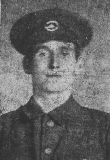
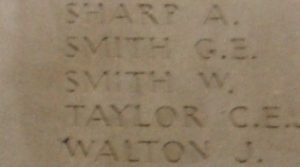
Samuel Starr, Private, 25129, Welsh Regiment. Samuel was born in Frome, Somerset in 1873, the son of William Henry Starr and Agnes Starr (nee Lapham). He married Susannah Hedges in Melksham in 1893 and the couple moved to 22, Glanant Street, Hirwaun, where Samuel had gained work as a colliery repairer. Samuel enlisted at Aberdare into the 17th Battalion, Welsh Regiment during the spring of 1915. The battalion had been raised in January 1915 as a Bantam Battalion, made up of men of below average height, and initially went to Porthcawl attached to the 43rd (Welsh) Division. During July 1915 the battalion moved to Prees Heath to join 119 Brigade, 40th (Bantam) Division and landed in France with the Division in June 1916. The Division moved to positions around Lillers before taking over the North Maroc Sector, near Loos, for trench initiation and once acclimatised was left to hold the sector itself over the coming months. The infantry battalions of the Division then began the usual routines of rotating for duty in the trenches: normally four days in the front line; four in support and four in reserve. Samuel was wounded by shrapnel whilst outside his billets at Bully Grenay on 25 July and was evacuated to the hospital at Bethune for treatment. He died there of his wounds on 29 July 1916. The 42-year-old was buried in Bethune Town Cemetery, France.
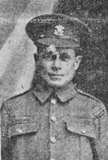
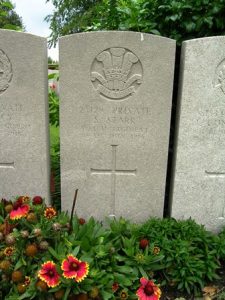
Alfred Thomas, Private, 91636, Durham Light Infantry. Alfred was born at Lichfield House, Treharris in 1895, the son of Thomas Thomas and Mary Ann Thomas. His father bought the Cardiff Arms at Hirwaun prior to the war. Alfred worked as a collier repairer at Hirwaun prior to enlisting into the Royal Field Artillery at Merthyr on 27 August 1914. He was posted to the depot at Preston for training but was discharged from there as medically unfit on 4 January 1915. Alfred then returned to work in the colliery at Hirwaun. He re-enlisted at Cardiff into the 4th (Reserve) Battalion, Welsh Regiment on 6 December 1917 and was posted to Llanion Barracks in Pembroke for training. On 11 April 1918 Alfred embarked for France and was posted to the 1/6th Battalion, Durham Light Infantry, joining the battalion at Cohem, near Aire on 19 April. The battalion was attached to 151 Brigade, 50th (Northumbrian) Division and was rebuilding following heavy losses suffered the previous month during the opening phases of the German Spring offensive of 1918, both during Operation Michael, on the Somme front, and Operation Georgette, on the Lys. Following this terrible time on the Somme and Lys battlefields, the Division was withdrawn and sent to IX Corps on the Aisne, believed to be a much quieter area. This was unfortunately not the case, as the Division was hit hard by a surprise enemy attack, the third phase of the German offensive, Operation Blücher-Yorck, which was launched on the Aisne on 27 May 1918. Alfred was posted as missing during the first days of this fresh fighting and was later found to have been captured and taken prisoner by the Germans. Sadly, he died at a German casualty clearing station at Fôret à Busy on 6 August 1918, his cause of death not reported. The 23-year-old was originally buried in the communal cemetery at Nouvion-en-Catillon, but after the war his grave was exhumed and Alfred was re-interred in Grand-Seraucourt British Cemetery, Aisne, France.
Geoffrey Lynn Thomas, MC, Captain, Royal Field Artillery. Geoffrey was born in 1894, the son of Doctor Ieuan George Thomas and Mary Jane Thomas (nee White), of Maesyffrwd, Hirwaun. His father was from Newcastle Emlyn, and his mother from Haverfordwest, but had moved the family to Hirwaun where Ieuan practised as a GP. Geoffrey was educated at Aberdare County School and then studied agriculture at Reading University College, where he had joined the Officer Training Corps. He was given a commission into the Royal Field Artillery in November 1914 and proceeded to France on 10 September 1915, with the 95th brigade, Royal Field Artillery, seeing his first action during the Battle of Loos. The battery was attached to the 21st Division and fought during the Battle of the Somme throughout the summer of 1916. Geoffrey was awarded the Military Cross on the Somme: ‘For conspicuous gallantry in action. An ammunition dump being set on fire, he led a party and extinguished the flames, displaying great courage and coolness. He set a fine example to his men.’ He saw further action with the division during the Battles of Arras and Passchendaele in 1917, and during the latter weeks of the year took part in the Battle of Cambrai. The 21st Division wintered in the Somme sector and was caught up in heavy fighting during the opening phases of the German Spring offensive of 1918, both during Operation Michael, on the Somme front, and Operation Georgette, on the Lys. Following this terrible time on the Somme and Lys battlefields, the Division was withdrawn and sent to IX Corps on the Aisne, believed to be a much quieter area. This was unfortunately not the case, as the Division was hit hard by a surprise enemy attack, the third phase of the German offensive, Operation Blücher-Yorck, which was launched on the Aisne on 27 May 1918. Geoffrey survived the worst of the fighting over the coming days but was killed in action when his gun battery was targeted by German artillery, and he was killed by shrapnel on 6 June 1918. The 25-year-old was buried in Marfaux British Cemetery, France.
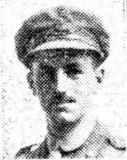
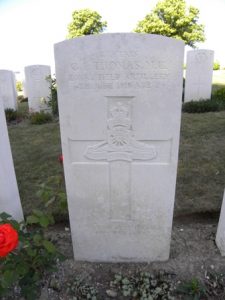
James Warner, Private, 13063, South Wales Borderers. James was born in 1889, the son of William Warner and Annie Warner (nee Sullivan). His parents were both from Hirwaun but had moved to 247, Ynyscynon Road, Trealaw by 1886. James had enlisted into the Welsh Regiment at Tonypandy on 3 October 1906 and served with the 1st Battalion, Welsh Regiment in Egypt for several years. He then left the army and returned home, but re-enlisted soon after the outbreak of war, joining the South Wales Borderers. James was drafted out to France on 13 November 1914 to join the 1st Battalion, South Wales Borderers, which was attached to 3 Brigade, 1st Division. The battalion was rebuilding following heavy losses during the retreat from Mons to the Marne, and then at the First Battle of Ypres, where the 1st Division had helped stop the German drive to capture the vital city. After wintering in Flanders, the division took part in the Battle of Aubers Ridge the following spring, before moving south to take part in the Battle of Loos from 25 September onwards. James was wounded at Loos and after treatment in France returned to Britain for further treatment in hospital at Birmingham. He then came home on furlough, to recover fully before being drafted back out to France but died at home of a ruptured blood vessel on 1 October 1915. The 26-year-old was buried in Trealaw Cemetery, Rhondda. His brother, John, also fell during the war. Neither man is commemorated on the Hirwaun war memorial. Their brother-in-law, Joseph George Fry, was killed in Mesopotamia in 1917.
John Warner, Private, 46185, South Wales Borderers. John was born at Hirwaun in 1879, the son of William Warner and Annie Warner (nee Sullivan). His parents were both from Hirwaun but had moved to 247, Ynyscynon Road, Trealaw by 1886. John had enlisted at Tonypandy into the Somerset Light Infantry in 1898 and served in South Africa during the Anglo Boer War with the 2nd Battalion, Somerset Light Infantry, seeing substantial action, taking part in the affairs at Cape Colony, Orange Free State, Transvaal, Tugela Heights and in the Relief of Ladysmith. He had left the army by 1911 and was back at Trealaw, working as a coal hewer. John re-enlisted into the 11th Battalion, Royal Welsh Fusiliers soon after the outbreak of war. The battalion was attached to 67 Brigade, 22nd Division and embarked for France on 5 September 1915. It’s stay in France was short, however, and on 30 October the division sailed from Marseilles for Salonika, to join the rapidly expanding Anglo-French force, which was building there to aid the Greeks, following the invasion of neighbouring Serbia by an Austro-Bulgarian offensive. John was to spend the rest of his war in Salonika, being transferred to the 7th Battalion, South Wales Borderers in the same 22nd Division. He was killed in action there during the Second Battle of Doiran on 18 September 1918, the last major action of the campaign. The 39-year-old has no known grave and is commemorated on the Doiran Memorial, Greece. His brother, James, also fell during the war. Neither man is commemorated on the Hirwaun war memorial. Their brother-in-law, Joseph George Fry, was killed in Mesopotamia in 1917.
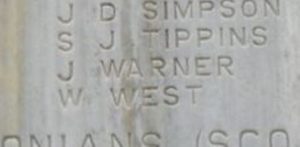
Alfred James Watson, Gunner, RMA/8439, Royal Marine Artillery. Alfred was born at Hilperton, Wiltshire on 5 October 1880, the son of James Watson and Mary Watson. His mother died in 1887, and on 10 October 1889 Alfred left home to enlist at Trowbridge into the Royal Marines. He was posted to Eastney for training, becoming a Gunner with the Royal Marine Artillery, and over the coming years had several postings aboard a wide variety of ships. Alfred married Sarah Ann Smith at South Stoke, Somerset on 2 April 1904 and the couple set up home at 4 Highland Place, Highland Road, Eastney, Portsmouth. Alfred continued to serve with the Royal Marine Artillery over the coming years, until leaving the forces in October 1911 and moved his young family to Crawshay Street, Hirwaun, where he had gained work. As soon as war was declared, Alfred re-enlisted into the Royal Marine Artillery and was posted aboard the armoured cruiser, HMS Good Hope. Just after joining the ship, Good Hope was ordered to reinforce the 4th Cruiser Squadron and became the flagship of Rear Admiral Christopher Cradock, who moved his squadron later that month to the coast of South America to search for German commerce raiders. He was then ordered further south to the Strait of Magellan to block any attempt of the German East Asia Squadron to penetrate into the South Atlantic. The squadron came into contact with the German squadron on 1 November off the coast of Chile, but was drastically outnumbered, and Good Hope and HMS Monmouth were sunk with all hands. Alfred was 34 years old when he was lost in the sinking of HMS Good Hope on 1 November 1914. He has no known grave and is commemorated on the Portsmouth Naval Memorial, Hampshire. Alfred is not commemorated on the Hirwaun war memorial.
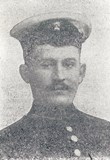
World War 2, 1939-1945
John Andrews, Private, 3959646, Royal Warwickshire Regiment. John was born in 1920, the son of David and Lydia Andrews (nee Drew), of Pant-y-Caran House, Hirwaun. John enlisted into the army soon after the outbreak of war and was posted to the 2nd Battalion, Royal Warwickshire Regiment. John probably joined the battalion following its evacuation from Dunkirk in May 1940. The battalion had by then transferred to the 144th Infantry Brigade, 48th (South Midland) Infantry Division, and was in Somerset. In early December, however, the battalion was transferred to the 24th Independent Guards Brigade Group, alongside the 1st Scots Guards and the 1st Welsh Guards and was stationed in London under command of London District. In September 1942, the battalion was transferred to the 185th Infantry Brigade, 79th Armoured Division, however, the brigade was then transferred to the 3rd Infantry Division and landed on D-Day on 6 June 1944 as part of the opening assault on the Normandy beaches. The battalion fought throughout the Battle for Caen and the breakout from Normandy, through Northern France into Belgium and Holland over the coming months. John was killed in Holland on 8 November 1944. The 24-year-old is buried in Overloon War Cemetery, Netherlands. An uncle, John Drew, was killed during the Great War.
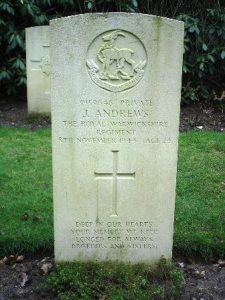
Percy George Baller, Guardsman, 2733653, Welsh Guards. Percy was born in 1914, the son of Percy George Baller and Elizabeth Baller (nee Weston), of 13, Cross Street, Hirwaun. He married Tegwen Mary Short in London in 1937. Percy enlisted into the Welsh Guards soon after the outbreak of war and was posted to the 1st Battalion, Welsh Guards. The battalion was in France with the BEF at the outbreak of war and was almost annihilated during the Battle of Arras, before the survivors were evacuated from Dunkirk. The battalion then spent much of the war on home defence, before returning to France as part of the Guards Armoured Division in June 1944, to take part in the terrible fighting to break-out of the Normandy Beach-Head. The battalion then took part in the fighting for Caen, in the countryside known as the Bocage, over the coming weeks. Percy was killed in Normandy on 12 August 1944. The 30-year-old is buried in St. Charles De Percy War Cemetery, France.
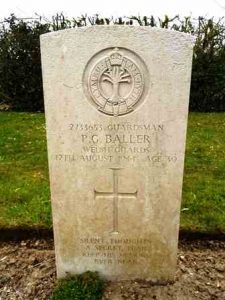
John Kenneth Blower, Able Seaman, Merchant Navy. John was born on 1 January 1908, the son of John Blower and Marian Francis Blower (nee Wilkes), of Stone House, St. Julian’s Friers, Shrewsbury. He left home as a young man to join the Merchant Navy, and in 1929 married Edna Beryl John, of The Cottage, Penderyn Road, Hirwaun. John was posted aboard the Bideford registered cargo steamer, SS Bradfyne following the outbreak of war. On 9 November 1940 Bradfyne left Sydney, Nova Scotia, for Belfast, carrying a cargo of 7,900 tons of grain, as part of Convoy SC-11. During the early hours of 23 November 1940, Bradfyne was hit amidships by a torpedo which had been fired from the German submarine U-100 and sank southeast of Rockall, with the loss of 39 lives. Four survivors were picked up from a lifeboat two days later and landed at Belfast. John was 32 years old when he was killed during the sinking of Bradfyne. He has no known grave but the sea, so is commemorated on the Tower Hill memorial, London.
Stanley George Brockway, Flight Sergeant, 1312981, Royal Air Force Volunteer Reserve. Stanley was born in 1919, the son of George Henry Brockway and Lilian Susan Brockway (nee Gowen), of Hirwaun. He had enlisted into the Royal Air Force Volunteer Reserve soon after the outbreak of war and after gaining his pilots wings, served as a pilot with 423 Squadron, RAF, which was a Coastal Command squadron, based at Lough Erne, in Co. Fermanagh. He married Lily Doris Williams whilst home on leave in the spring of 1943 and the couple set up home at 94, Brecon Road, Hirwaun. Stanley returned to Northern Ireland to re-join the squadron soon afterwards. On 13 November 1943 Stanley was flying a Coastal Command Short Sunderland IIII on convoy escort duties off Western Approaches, when the aircraft suffered engine failure. He tried to get the Sunderland safely back to base, but due to a lack of power was forced to ditch into the sea off the Irish coast. Unfortunately, the heavy swells caused the Sunderland to crash upon hitting the water and it sank with the loss of her crew. Stanley was 24 years old when he was killed that day and is commemorated on the Runnymede Memorial, Surrey. His cousin, Raymond Butt, was also killed during the war.
Raymond George Butt, Sergeant, 930644, Royal Air Force Volunteer Reserve. Raymond was born in 1921, the son of Alfred Francis George Butt and Maud Butt (Nee Gowen), of 6, Penmark Row, Hirwaun. He enlisted into the Royal Air Force Volunteer Reserve soon after the outbreak of war and after training as a Wireless Operator/Air Gunner was posted to 75 Squadron, Royal Airt Force, which was an RAF Bomber Command unit, based at RAF Feltwell. On the evening of 12 October 1941, Raymond took off from Feltwell aboard a Vickers Wellington IC, Serial X9981, which was part of a large force of bombers despatched to destroy targets in Nuremberg. Raymond was killed when his Wellington was shot down by a German night fighter some two miles from Dinant whilst on the outbound leg of the mission and crashed with the loss of all six of her crew. Raymond was 20 years old when he was killed that night and is buried with his fellow crewmen in Dinant (Citadelle) Military Cemetery, Belgium. His cousin, Stanley Brockway, was also killed during the war.

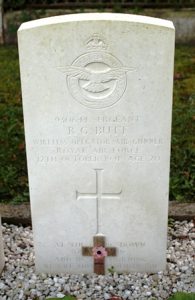
William Frederick Chislett, Marine, EX/4852, Royal Marines. William was born at Ebbw Vale on 18 October 1919, the son of Frederick Chislett and Edith Chislett (nee Sutton). The family moved to Cross Street, Hirwaun some years prior to the war. William enlisted into the Royal Marines and was posted to the 11th Battalion, Royal Marines, which was a Mobile Naval Base Defence Organisation unit (M.N.B.D.O.), at Fort Cumberland. It moved to Plymouth in March 1940 and to Hayling Island in May 1940, forming part of the defence of Deal. The battalion embarked for Egypt on 4 February 1941 and moved to Tahal Camp in Egypt upon its arrival. The battalion served in Egypt on various defensive duties until August 1941 when it became attached to Commander in Chief Mediterranean as an independent battalion. The battalion raided Kupha Nisi island near Crete on 15/16 April 1942, destroying enemy installations, but saw its most difficult task of the war when it took part in the raid on Tobruk from 13 September 1942. William was killed on the following day, 14 September 1942. The 23-year-old is buried in Tobruk Cemetery, Libya.
Raymond Davies, Private, 14635653, South Staffordshire Regiment. Raymond was born in 1924, the son of David John Davies and Edith Ellen Davies (nee Brock), of 1, Maesycynon, Hirwaun. He enlisted into the army as soon as he turned eighteen and was posted to India to join the 1st Battalion, South Staffordshire Regiment. The battalion was attached to the 77th Indian Infantry Brigade and was part of Orde Wingate’s famous Chindit force. Raymond arrived in time to join the battalion just prior to the launch of Operation Thursday, the second Chindit expedition into Japanese occupied Burma. He would have been present in the famous action of 18 March 1944, when Lieutenant George Cairns was posthumously awarded the Victoria Cross when the 1st South Staffs were attacked by an overwhelmingly superior Japanese force but managed to fight it off. Raymond was killed later in the expedition, whilst fighting behind enemy lines on 11 June 1944. The 19-year-old has no known grave and is commemorated on the Rangoon Memorial, Myanmar.
William James Edgar Davies, Lance Corporal, 3976140, Welch Regiment. William, known as Edgar, was the son of David James Davies and Mary Davies, of Penbryn, Hill Street, New Quay. He was educated at Aberaeron Secondary School prior to moving to Hirwaun some years before the war. William married Winifred Jones at Hirwaun in the spring of 1942. He had probably already enlisted into the Welch Regiment, so would have been on leave. He then embarked for North Africa to join the 1st Battalion, Welch Regiment. The battalion had been totally rebuild following its virtual annihilation in Crete in May 1941 and moved to Egypt to take part in the arduous campaign in the Western Desert and was again virtually annihilated at Benghazi. Following the surrender of the Axis forces in Tunisia in 1943, the Allies began their liberation of Italy, firstly by invading Sicily and the 1st Welch landed on the island on 9 July 1943. Following the fall of Sicily, the 1st Welch crossed the Messina Straits and landed in mainland Italy on 3 September. Edgar was killed in Italy soon afterwards, on 1 October 1944. The 27-year-old is buried in Cesena War Cemetery, Italy.
Morgan Edwards, Sergeant, 1072140, Royal Air Force Volunteer Reserve. Morgan was born on 5 August 1914, the son of David Edwards and Anne Edwards (nee Williams), of 3, Railway View, Hirwaun. He trained as a schoolteacher prior to the war. He enlisted into the Royal Air Force Volunteer Reserve and after completing his training as a Navigator, was posted to 304 Ferry Training Unit at Port Ellen, Argyll, where he continued specialist training in preparation to join an RAF Coastal Command unit. On 17 May 1943, Morgan was flying aboard a Bristol Beaufighter XI, Serial JM244, on a training flight from Port Ellen, when the aircraft hit the ground at Ferndale and burst into flames, killing Morgan and his pilot, David John Underwood, of Mardy. Morgan was 28 years old when he was killed that day and his remains were brought home for burial in Bryn-y-Gaer Cemetery, Aberdare. His pilot was buried in Ferndale Cemetery. With both men being from South Wales, it was even more of a tragedy for them to be killed whilst flying over their homes.
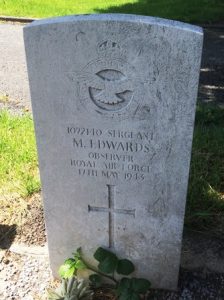
Idris Morton Evans, Leading Aircraftman, 637368, Royal Air Force. Idris, known as Morton, was born in 1919, the son of John Trevor Evans and Margaret Blodwen Evans (nee Fry), of 28, Glanant Street, Hirwaun. He enlisted into the Royal Air Force soon after the outbreak of war and was posted to 84 Squadron, Royal Air Force. The squadron was equipped with Bristol Blenheim’s, and had been in Palestine when war broke out. The squadron saw its first action when Iraqi forces attacked the RAF base at Habbaniya, west of Baghdad, and following the relief of Habbaniya, began carrying out operations against airfields in Vichy-French Syria. The squadron then took part in the invasion of Syria and Lebanon, and in the Anglo-Soviet invasion of Iran before moving to Egypt and to carry out operations over the Western Desert. Following the Japanese invasion of Malaya in December 1941 the squadron was transferred to the Far East, arriving in Sumatra in late January 1942. When the Japanese began landing on Sumatra in February 1942 the squadron evacuated to Java, but by then had lost all its Blenheim’s. Idris was taken prisoner by the Japanese when Java fell on 8 March 1942 and was marched into captivity. He died as a prisoner of war on 26 September 1944. Some reports state that he died of malnutrition and was buried on land, but other reports state that he died aboard the Japanese Hellship, SS Kenzen Maru. The 25-year-old has no known grave and is commemorated on the Singapore Memorial, Singapore.
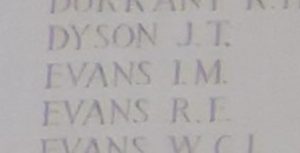
Kenneth James Garrett, Sergeant, 613909, Royal Air Force. Kenneth was born at Hirwaun on 11 February 1919, the son of John Garrett and Gwladys Garrett (nee Evans). The family then moved to his mothers native Swansea, but following her death in 1927, returned to Hirwaun. Kenneth enlisted into the Royal Air Force and after completing his training as an Observer was posted to 272 Squadron, Royal Air Force. The squadron had reformed on 19 November 1940 at RAF Aldergrove, initially equipped with Bristol Blenheim’s, but soon converted to the faster Bristol Beaufighter’s. It then moved to RAF Idku, in Egypt to take part in operations over the Western Desert, harassing enemy aerodromes, transport aircraft and lines of communication. On 14 June 1942, Kenneth took off from Idku aboard Bristol Beaufighter Ic, Serial T4867, as part of a number of aircraft sent to escort the naval convoy Vigorous, south of Crete. Kenneth was killed that day when his Beaufighter was intercepted and shot down by a German Bf109 Northeast of Derna, Libya and crashed into the sea. The 23-year-old has no known grave and is commemorated on the Alamein Memorial, Egypt.
Edgar Thomas George, Petty Officer Stoker, P/KX 85467, Royal Navy. Edgar was born on 28 May 1916, the son of Samuel Washington Thomas George and Ethel george (nee Nicholas), of Bassaleg. His parents moved back to Hirwaun soon after his birth. Edgar enlisted into the Royal Navy soon after the outbreak of war and was posted aboard the V-class destroyer HMS Vortigern. She had initially served during the Great War but had been modernised and refitted before joining the 17th Destroyer Flotilla following the outbreak of the Second World War. Vortigern then spent the coming months based at Plymouth, tasked with escorting convoys and carrying out anti-submarine patrols in the South Western Approaches and the English Channel, before being deployed to Gibraltar in January 1940, before taking part in escorting convoys between Britain and Gibraltar. Later in 1941 she returned to Britain to carry out escort duties for convoys sailing in the North Western Approaches to and from the Clyde. On 15 March 1942, Vortigern was escorting a coastal convoy past Cromer, in Norfolk, when she was torpedoed by the German E-boat S104 and sank with the loss of 110 lives. Edgar was 25 years old when he was killed in the sinking. He has no known grave and is commemorated on the Portsmouth Naval Memorial, Hampshire. Edgar is not commemorated on the Hirwaun war memorial.

James Verdon Green, Private, 14342628, Border Regiment. James, known as Verdon, was born on 4 June 1916, the son of James Green and Frances Green (nee Barry), of Hirwaun. He married Nancy Hopkins in 1940 and the couple set up home at Elm Grove, Hirwaun. James enlisted into the army and was posted to Burma to join the 2nd Battalion, Border Regiment. In 1942, the battalion moved from India to Ceylon and later took part in the Burma Campaign. James was posted as missing in Burma on 6 December 1943. His widow, Nancy, received news on Christmas Day 1943 of his being missing and it was not until 1953 that she received official confirmation of his death. Their only child, Gloria Elizabeth, had just had the honour of presenting the newly crowned Queen Elizabeth with a bouquet during her first visit to Wales as monarch. James was 27 years old when he was presumed dead and his name was added to the Rangoon Memorial, Myanmar.
Reginald Herbert Hale, Chief Stoker, D/K 66469, Royal Navy. Reginald was born at Ogmore on 6 February 1904, the son of Ernest Alfred Hale and Mary Hale (nee Mayo). The family had moved to 78, Tramway, Hirwaun just prior to the outbreak of the Great War. Upon leaving school, Reginald worked as a coalminer, but on 7 July 1925 he enlisted into the Royal Navy, signing up for twelve years’ service. He underwent his training at HMS Vivid II, and enjoyed his first posting, aboard the mighty battleship HMS Hood, on 4 December 1925. Reginald served aboard Hood for almost three years before returning to HMS Vivid II, then on 8 September 1928 was posted HMS Defiance, the training establishment at Portsmouth. Following the outbreak of war, Reginald was posted aboard the Hunt class minesweeper HMS Huntley. She was an antiquated minesweeper which had been launched in 1919, and was in reserve when war was declared, before being rapidly recommissioned and despatched to join the Mediterranean fleet. On 31 January 1941, Huntley was on duty off the Egyptian coast, some 30 miles northwest of Mersa Matruh, when she was attacked by German aircraft and sank with the loss of 28 lives. Reginald was 36 years old when he was killed during the sinking of Huntley that day. He has no known grave and is commemorated on the Plymouth Naval Memorial, Devon.
Arthur Rupert Lewis, Flight Sergeant, 1193204, Royal Air Force Volunteer Reserve. Arthur, known as Rupert, was born in 1915, the son of Evan Lewis and Ann Jane Lewis (nee Jones), of Maesyrhidiau Farm, Hirwaun. He was educated at Christ College, Brecon prior to enlisting into the Royal Air Force Volunteer Reserve and after completing his training as a Navigator was posted to 207 Squadron, Royal Air Force, which was an RAF Bomber Command unit, based at RAF Langar. On the night of 9 April 1943, Arthur took off from Langar aboard an Avro Lancaster I, Serial ED554, as part of a large bomber group despatched to hit targets in Duisberg. The Lancaster was intercepted by a German night fighter and shot down at 22:42 that same day, 9 April 1943, crashing into the ground and exploding at Jisp, Noord Holland, two miles northeast of Wormerveer, killing all seven of her crew. Arthur was 28 years old when he was killed that night and is buried in a collective grave, together with the remains of his fellow crewmen, in Amsterdam New Eastern Cemetery, Netherlands.
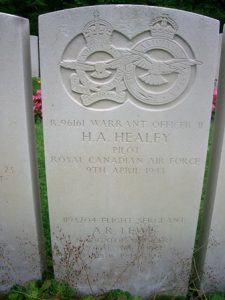
Idris George Lewis, Private, 3911481, South Wales Borderers. Idris was born on 8 January 1916, the son of Lewis Lewis and Sarah Ann Lewis (nee Marshall). The family had moved to Lambeth prior to the war and Idris found work there as a locomotive engine cleaner. He returned to Wales to enlist into the army and was posted to the 6th Battalion, South Wales Borderers. The battalion sailed for Bombay in October 1942, before being sent into Burma to join the campaign against the Japanese in the dreaded Arakan. The battalion took part in the brutal fight for the Mayu Tunnels in March 1944, before being sent to Ledo to reinforce the American Chinese forces operating in North Burma under General Stillwell. The battalion then saw heavy fighting at Sahmaw Chaung, before continuing the press the now beleaguered Japanese and in October attacked their positions at Pinwe. Idris was killed during the brutal fighting around the village of Gyobin Chaung on 23 November 1944. The 29-year-old was originally buried in Sahmaw Christian Cemetery, but in June 1954 the war graves within the cemetery were exhumed and re-interred into Taukkyan War Cemetery, Myanmar.
John Meirion Lloyd, Private, 14623485, Monmouthshire Regiment. John, known as Meirion, was born in Hirwaun in 1925. He enlisted into the army and was posted to the 2nd Battalion, Monmouthshire Regiment. The battalion was mobilised on the outbreak of war as part of the 160th Infantry Brigade, 53rd (Welsh) Infantry Division and spent much of the early years of the war on home defence duties and training in Northern Ireland and Southern England. The division landed in Normandy on 28 June 1944, and fought in the Normandy Campaign, seeing heavy fighting during Operation Epsom and in the Battle for Caen and also fought during the terrible fighting in the Falaise Gap, where the division suffered heavily. Following the break-out from Normandy, the division took part in the drive north through France, liberating Merville and became the second division to reach Ypres, after the Poles. The division then took part in the drive into Holland, and by October they had reached the Nederrijn, before liberating the town of ‘s-Hertogenbosch. In December 1944 the division took part in the counter offensive against the German advances in the Ardennes Forest, helping relieve the besieged US forces which had become isolated during the Battle of the Bulge. In January 1945 the division moved back into Holland for a period of training prior to Operation Veritable, the Battle of the Reichswald. The division entered Germany on 8 February and took part in the desperate fighting to consolidate the Rhine crossings. The division then enjoyed a brief rest before continuing the advance across Germany, forcing a crossing of the River Aller at Rethem on 11 April 1945. John was killed near Rethem on 16 April 1945. The 20-year-old was originally buried in a battlefield cemetery at Wittlohe, but in July 1946 the war graves within the cemetery were exhumed and re-interred in Becklingen War Cemetery, Germany.
Andrew Shennan Neilson, DSO, Captain, 219064, Scots Guards. Andrew was born at Cardiff on 5 March 1921, the son of Doctor Andrew Shennan Neilson and Hettie Ruthin Neilson (nee Sarvis). His mother was from Hirwaun, and her family ran a successful Drapery business in Aberdare. Andrew was educated at Cheltenham College prior to gaining a commission as Second Lieutenant into the Scots Guards. Andrew was then attached with his Company, ‘S’ Company, to the 2nd Battalion, Coldstream Guards. The battalion took part in the evacuation from Dunkirk in May 1940 and upon returning to England rebuilt before embarking for Tunisia with the 1st Guards Brigade in later 1942 and saw heavy fighting throughout the campaigns in North Africa and the Western Desert. Following the surrender of the Axis forces in North Africa on 13 May 1943, and the subsequent invasion of Sicily by the Allies, the 1st Guards Brigade landed on mainland Italy, at Salerno, in September 1943 and began the long and arduous campaign north, to clear the country of the occupying Germans. Andrew gained the award of the Distinguished Service Order during the Italian campaign. The citation for his award reads: ‘The 2nd Bn Coldstream Guards was ordered to carry out a night attack, crossing the start line at 0015 hrs 28th May 1944. It was ordered to capture and hold the Piccolo feature (6530). Capt Neilson commanded the Scots Guards Coy with skill, speed and accuracy across most steep, difficult and enclosed country and took his objective. After daylight his coy was counter-attacked and one of his offrs was killed, but the enemy was repulsed and his coy again held the crest. They were subjected throughout the day to mortar fire, sniping and grenades. Its flanks were frequently threatened by German infiltration, but by skilful manoeuvre and complete disregard for his personal safety while walking about to encourage his men, Capt Neilson retained his objective. During this time Capt Neilson was wounded in the arm but refused to leave his coy until the posn was stabilised somewhat, and in consequence lost a great deal of blood. After having his wound dressed at the R.A.P., Capt Neilson returned to his coy against the strong advice of the Medical Offr. Shortly after his arrival back with his coy a strong counterattack was put in by the enemy all along the Bn posn. Capt Neilson again walked about in the open encouraging and manoeuvring his men until a near miss from a shell and weakness from his previous loss of blood caused him to faint twice and he was carried from the battlefield unconscious. There is no doubt that Capt Neilson’s skill, complete disregard for his personal safety and determination to remain with his coy when wounded were major factors in enabling his coy and consequently the Bn to gain and retain its objective in spite of determined and prolonged assault upon it by the enemy.’ Andrew never lived to receive his award, as he was killed by a German mine on 16 July 1944. The 23-year-old was originally buried on the battlefield, but in April 1945 his grave was exhumed, together with several other burials in the locality, and he was re-interred in Assisi War Cemetery, Italy. His mother, Hettie, had just been killed by a V1 rocket in London the previous month. Andrew is not commemorated on the Hirwaun war memorial.
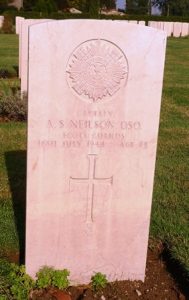
Hettie Ruthin Neilson (nee Sarvis), Civilian. Hettie was born on 5 February 1881, the daughter of William Sarvis and Mary Jane Sarvis (nee Jones, of 16, The Garth, Hirwaun. Her father ran a successful Drapery business in Aberdare and most of the family worked there. Hettie married Doctor Andrew Shennan Neilson, a GP at Trecynon, at St. Bride’s Major on 16 September 1915. The couple lived in Cardiff before retiring to Cheltenham prior to the war. Following her husband’s death, Hettie moved to 78, Murray House, Vandon Street, London, SW1, where she lived throughout the coming years. On 18 June 1944 Hettie went to the Guard’s Chapel at Wellington Barracks to attend a Church service. Following the readings, the tightly packed congregation were silenced by the familiar noise of a dreaded V1 Doodlebug rocket, when it went silent and tragically crashed into the Chapel, bringing the roof down on the congregation. Hettie was among 121 people killed during the tragic event that morning. The 61-year-old is commemorated in the Civilian Book of Remembrance in Westminster Chapel. Her son, Andrew Shenna Neilson, was killed in Italy just a month later. Neither are commemorated on the Hirwaun war memorial.
Reginald Lewis Nunn, Captain, DSO, Royal Air Force Volunteer Reserve. Reginald was born at Tenderden, Kent on 11 September 1892, the son of Albert Edgar Nunn, a Civil Engineer, and Frances Ellen Nunn (nee Turner), of Woodbury, Tenderden. Both Reginald and his brother Hubert followed in their father’s footsteps and trained as Civil Engineers at Brighton College. Their father had gained the contract to build the Rhondda Waterworks, so the entire family moved to Hirwain by 1909. Tragically the following year, whilst on holiday in Norfolk, the boy’s mother shot and killed their father in a fit of jealousy before killing herself at the Cliftonville Hotel in Cromer on 17 July 1910. Both Reginald and Hubert remained at Hirwain to continue their work and both men enlisted into the Royal Marine Engineers on 1 October 1914, following the outbreak of war. Hubert was killed at Gallipoli in 1915, whilst Reginald survived the war, gaining the award of the Distinguished Service Order and was Mentioned in Despatches twice, serving with the Royal Marines and then the Royal Engineers. Reginald married Gertrude Higgs at Checkendon, Oxfordshire on 20 March 1918. Following the Armistice, he returned to civilian life and the couple travelled the world as a result of Reginald’s work. Prior to the outbreak of the Second World War Reginald gained the role of Director of Public Works at the British colony of Singapore and the couple set up home in 180, Mount Pleasant Road, Singapore. Following the invasion of Malaya by the Japanese in December 1941 and the subsequent siege and surrender of Singapore on 15 February 1942, Reginald and his wife Gertrude managed to escape and boarded the Dutch steamship SS Roosemboom at Padang, together with some 500 other evacuees. On 1 March 1942 Roosemboom was steaming some 300 miles from her destination of Colombo, in Ceylon, when she was torpedoed and sunk by the Japanese submarine I-59. The ship sank quickly, leaving just one lifeboat afloat, with 80 people aboard, and some 135 people in the water. Reginald died on the first day, on 1 March 1942, whilst his wife Gertrude died aboard the lifeboat on 9 March. The story of the lifeboat is a gruesome one, too long for this write up. Reginald was 49 years old, the same age as his wife, Gertrude. He is not commemorated on the Hirwaun war memorial.
Edward Douglas Panniers, Flight Sergeant, 1314367, Royal Air Force Volunteer Reserve. Edward, known as Douglas, was born on 4 March 1916, the son of William Joseph Panniers and Eliza Jane Ethel Panniers (nee Lewis), of Hirwaun. He worked as a colliery worker prior to the war. Edward enlisted into the Royal Air Force Volunteer Reserve and after completing his training as a Wireless Operator/ Air Gunner was posted to 156 Squadron, Royal Air Force, which was an RAF Bomber Command unit, based at RAF Warboys. The squadron was an elite Pathfinder Unit, whose role was to accurately navigate to and mark targets for the main bomber force which attacked behind them. On the night of 14 January 1944, Edward took off from Warboys aboard an Avro Lancaster III, Serial JB483, leading a large group of some 498 bombers sent to destroy targets in Brunswick. The Germans had tracked the bomber stream from just off the English coastline and despatched a large number of German night-fighters to intercept them. Edward was killed when his Lancaster was destroyed with all hands on its way to the target that night, one of five Lancaster’s lost from his squadron alone. The 27-year-old was buried with his crew near the crash site of their Lancaster at Gunsleben, but in 1948 their graves were exhumed, and all seven men were re-interred in Berlin 1939-1945 War Cemetery, Germany.
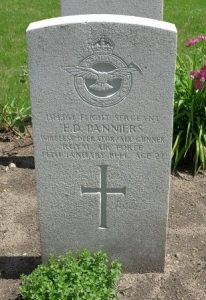
Trevor Llewellyn Ralph, Private, 14200943, Welch Regiment. Trevor was born in 1923, the son of Llewellyn Ralph and Catherine Janet Ralph (nee Davies), of Fairfield, John Street, Hirwaun. He enlisted into the army and was posted to the 5th Battalion, Welch Regiment, the local Territorial infantry unit. The battalion was attached to 158 Brigade, 53rd (Welsh) Division and spent much of the early years of the war on home defence duties and training in Northern Ireland and Southern England. The division landed in Normandy on 28 June 1944, and fought in the Normandy Campaign, seeing heavy fighting during Operation Epsom and in the Battle for Caen and also fought during the terrible fighting in the Falaise Gap, where the division suffered heavily. Following the break-out from Normandy, the division took part in the drive north through France, liberating Merville and became the second division to reach Ypres, after the Poles. The division then took part in the drive into Holland, and by October they had reached the Nederrijn. Trevor was killed at St. Oedenrode on 12 October 1944, during the build up to the divisions assault on ‘s-Hertogenbosch. The 21-year-old was originally buried at Kijnsel, but in June 1946 his grave was exhumed, and he was re-interred in Uden War Cemetery, Netherlands.
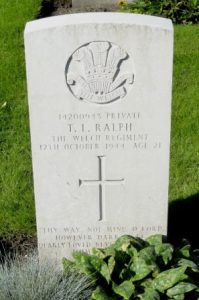
Howell John Rees, Private, 5259749, Worcestershire Regiment. Howell was born on 8 October 1914, the son of Joseph Rees and Jane Rees (nee Drew), of 17, Merthyr Road, Hirwaun. He worked as a coal hewer prior to the war. Howell enlisted into the army and was posted to the Worcestershire Regiment. He died on home service in west Glamorgan on 23 September 1945. The 30-year-old was buried in Bryn-y-Gaer Cemetery, Aberdare.
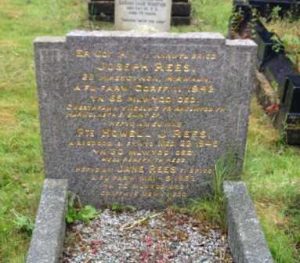
James Samuel, Private, 3959691, Welch Regiment. James was born in 1919, the son of James Samuel and Maria Samuel (nee Forey), of 20, Wind Street, Hirwaun. He enlisted into the army and then embarked for North Africa to join the 1st Battalion, Welch Regiment. The battalion had been totally rebuild following its virtual annihilation in Crete in May 1941 and moved to Egypt to take part in the arduous campaign in the Western Desert and was again virtually annihilated at Benghazi, where most of the battalion was either taken prisoner or killed. The survivors began to withdraw along the coast to the Egyptian border and became tangled up with various other units, so this period of the battalion’s history is somewhat chaotic. James is recorded as having died on 27 May 1942. The 22-year-old has no known grave and is commemorated on the Alamein Memorial, Egypt.
James Smith, Fourth Engineer Officer, Merchant Navy. James was born in 1908, the son of Benjamin Smith and Gwen Smith (nee Lewis), of 3, Watkins Court, Hirwaun. He left home as a young man to go to sea, joining the Merchant Navy and by the time war erupted was serving as Fourth Engineer Officer aboard the London registered steamship SS Empire Tower. James married Joan Bennett, of Newbridge, whilst on shore leave at the end of 1942. Early in 1943, Empire Tower, under the command of Captain David John Williams, OBE, joined Convoy XK-2 from Gibraltar to Britain. On 5 March 1943 the convoy was attacked by the German submarine U-130, which torpedoed Empire Tower, which sank in less than a minute with the loss of 42 lives. James was 35 years old when he died during the sinking. He has no known grave and is commemorated on the Tower Hill Memorial, London. James is not commemorated on the Hirwaun war memorial.
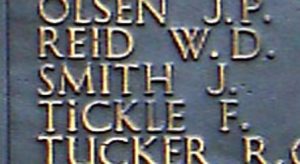
Harry Verrier, Private, 3957382, Welch Regiment. Harry was born in 1912, the son of Charles Verrier and Emma Verrier (nee Burnell), of 52, Tramway, Hirwaun. He married Mary Pritchard at Hirwaun in the spring of 1939. Harry was a regular soldier, and embarked for Palestine with the 1st Battalion, Welch Regiment in May 1939. The battalion struggled to maintain peace between the Jews and Arabs during its time in Palestine and the men were no doubt happy when the battalion left for Egypt in November 1939. The battalion moved to Mersa Matruh, then on 28 February 1940 the battalion embarked for Crete. The men then began to dig-in and prepare positions for an expected German invasion, which materialised on 14 May 1941 when some 600 German bombers began saturation bombing the island, followed by the landing of hundreds of elite German paratroopers. The 1st Welch fought a stubborn defensive effort, but were forced to withdraw to Suda Bay, where the bulk of the battalion was captured. Some 300 men managed to reach Sphakia and embarked upon a Royal Navy ship for evacuation to Alexandria but were again overwhelmed when they were caught up in the ferocious fighting at Benghazi. Harry died in Greece on 29 June 1941, so may have died as a prisoner of war. The 29-year-old is buried in Phaleron War Cemetery, Greece.
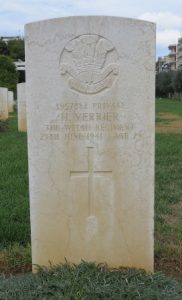
Joyce Walters, Sister, 215704, Territorial Army Nursing Service. Joyce was born on 26 October 1905, the daughter of William Walters and Hannah Jane Walters (nee Jones), of 17, High Street, Hirwaun. She trained as a nurse at the Park Royal Hospital in London prior to the war, and after a short period spent travelling around Canada, went to live at 19, Belsize Avenue, Hampstead, London. Joyce enlisted into the Territorial Army Nursing Service soon after the outbreak of war and volunteered for service abroad. In October 1942 she was returning to Britain aboard the cargo ship MV Stentor. The ship joined convoy SI-125 and was off the Canary Islands en-route from Lagos via Freetown for Liverpool, when on 27 October 1942 the convoy was sighted by the German submarine U-509. The submarine fired a torpedo at Stentor which hit her amidships, igniting a cargo of palm oil stored in her holds, which exploded out over the bridge, killing many of those onboard. Some 44 people were killed as a result of the explosion and the ship subsequently sinking. Joyce was 38 years old when she was killed that day and is commemorated on the Brookwood 1939-1945 Memorial, Surrey.
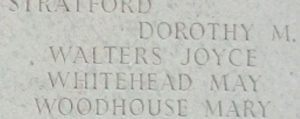
Ivor George Watkins, Stoker 1st Class, D/K 61158, Royal Navy. Ivor was born on 14 January 1904, the son of Oliver Watkins and Priscilla Watkins (nee Langley), of 124 Marine Street, Cwm, Rhondda. He worked as a collier after leaving school, but left home as a young man and enlisted into the Royal Navy on 14 February 1923. Ivor was posted to HMS Vivid II for training and received his first posting aboard the battleship HMS Resolution. Ivor then returned to HMS Vivid II, before being posted aboard another battleship, HMS Emperor of India, where he remained for almost 18 months. He then returned to HMS Vivid II, before receiving further postings aboard HMS Impregnable, HMS Dolphin, and HMS Lucia. In the spring of 1930 Ivor married Annie Mary Thomas, of Hirwaun, at Devonport. He continued to serve for another five years before leaving the Royal Navy on 14 February 1935 and was placed on the Royal Fleet Reserve. Ivor continued to attend his regular reservist training over the coming years, then with the declaration of war re-enlisted and was posted to HMS Drake, at Portsmouth. Ivor was then posted aboard the lend-lease destroyer HMS Cameron, which was the former US Navy ship, USS Welles. On 5 December 1940 HMS Cameron was moored in Portsmouth, undergoing a refit, when she was targeted during a German air raid and capsized. Ivor was killed during the attack that day. The 37-year-old was buried in Haslar Royal Naval Cemetery, Hampshire.
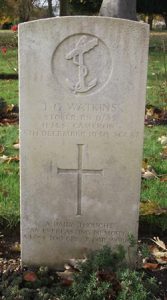
Charles Frederick White, Gunner, 1109057, Royal Artillery. Charles was born on 15 January 1918, the son of William Henry White and Margaret White (nee Giltinan), of Aberdare. He married Violet Mary Jones in the spring of 1936 and the couple resided at 29, New Houses, Penywain, Hirwaun. Charles worked as a collier prior to the war. He enlisted into the Royal Artillery and was posted to the 80th Anti-Tank Regiment, Royal Artillery. The regiment had formed at Hitchin, Hertfordshire in July 1941, before embarking for the Far East and arrived at Malaya in November. In December the Japanese launched their invasion of Malaya, in conjunction with their attack on Pearl Harbour, and Charles unit took part in fierce fighting as it withdrew to the fortress of Singapore. Charles was taken prisoner by the Japanese when Singapore was surrendered on 15 February 1942 and was marched into captivity. He died at No. 1 Camp, Thailand of chronic malnutrition and gastro-enteritis on 25 January 1945. The 27-year-old was originally buried in a POW cemetery in Formosa, but in the summer of 1947 the graves within the cemetery were exhumed and re-interred in Sai Wan War Cemetery, Hong Kong, China.
Maldwyn Beynon Williams, Gunner, 1123130, Royal Artillery. Maldwyn was born in 1911, the son of William Williams and Mary Williams, of 24, Bwllea Road, Aberdare. He enlisted into the Royal Artillery soon after the outbreak of war and married Muriel Williams, of Hirwaun, whilst on leave in the spring of 1943. Maldwyn was then posted to North Africa to join the 165th Field Regiment, Royal Artillery. The regiment fought throughout the North African campaign with the 231st Infantry Brigade, then following the surrender of the Axis Forces in North Africa, took part in the 8th Army’s invasion of mainland Italy. Maldwyn was killed during the drive through Italy, on 17 September 1944. The 36-year-old was originally buried on the battlefield together with a number of other men from his regiment, but in March 1945 their graves were exhumed and re-interred in Montecchio War Cemetery, Italy. Maldwyn is not commemorated on the Hirwaun war memorial.
Vincent Rees Macdonald Williams, Flying Officer, 164241, Royal Air Force Volunteer Reserve. Vincent was born in 1924, the son of John Williams and Mary Elizabeth Williams (nee Smith), of 3, Ivy Cottages, Hirwaun. He enlisted into the Royal Air Force Volunteer Reserve and after completing his training as a Navigator was posted to 138 Squadron, Royal Air Force, which was an RAF Bomber Command unit, based at RAF Tuddenham. On the night of 14 April 1945, Vincent took off from Tuddenham aboard an Avro Lancaster I, Serial RF143, which joined a large force of bombers sent to hit targets around Potsdam. During the early hours of the following morning, 15 April 1945, the Lancaster became caught up in searchlights and was intercepted and shot down by a German night fighter, killing all seven of her crew. Vincent was just 20 years old when he was killed that morning. He was originally buried in Doeberitz-Elsgrund, Germany alongside his fellow crewmen, but in December 1946 their graves were exhumed and re-interred in Berlin 1939-1945 War Cemetery, Germany.
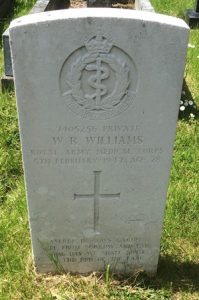
William Richard Williams, Private, 7405256, Royal Army Medical Corps. William was born on 26 October 1918, the son of John Williams and Mary Williams (nee Smith), of Hirwaun. He married Elizabeth Jane Phillips in the summer of 1939 and the couple set up home at 24, Davies Row, Hirwaun. William worked as a lead presser in a cable factory prior to the war. He enlisted into the army and was posted to the Royal Army Medical Corps. William served throughout the entire war but died in Cardiff on 5 February 1947. The remains of the 28-year-old were brought home to Hirwaun, and he was buried in Bryn-y-Gaer Cemetery, Aberdare.
William Thomas Wybourn, Private, 3959593, Welch Regiment. William, known as Thomas, was born in 1918, the son of Ernest Percival Wybourn and Margaret Elizabeth Wybourn (nee Williams), of 80, High Street, Hirwaun. William was a regular soldier, and embarked for Palestine with the 1st Battalion, Welch Regiment in May 1939. The battalion struggled to maintain peace between the Jews and Arabs during its time in Palestine and the men were no doubt happy when the battalion left for Egypt in November 1939. The battalion moved to Mersa Matruh, then on 28 February 1940 the battalion embarked for Crete. The men then began to dig-in and prepare positions for an expected German invasion, which materialised on 14 May 1941 when some 600 German bombers began saturation bombing the island, followed by the landing of hundreds of elite German paratroopers. The 1st Welch fought a stubborn defensive effort, but were forced to withdraw to Suda Bay, where the bulk of the battalion was captured. Some 300 men managed to reach Sphakia and embarked upon a Royal Navy ship for evacuation to Alexandria but were again overwhelmed when they were caught up in the ferocious fighting at Benghazi. William was killed in action on 21 May 1941. The 22-year-old has no known grave and is commemorated on the Athens Memorial, Greece.
